Forums
- Forums
- Axis And Allies Forum
- General Discussion
- Aviation News
Aviation News
Post a reply
- Go to Previous topic
- Go to Next topic
- Go to Welcome
- Go to Introduce Yourself
- Go to General Discussion
- Go to Screenshots, Images and Videos
- Go to Off topic
- Go to Works in Progress
- Go to Skinning Tips / Tutorials
- Go to Skin Requests
- Go to IJAAF Library
- Go to Luftwaffe Library
- Go to RAF Library
- Go to USAAF / USN Library
- Go to Misc Library
- Go to The Ops Room
- Go to Made in Germany
- Go to Campaigns and Missions
- Go to Works in Progress
- Go to Juri's Air-Raid Shelter
- Go to Campaigns and Missions
- Go to Works in Progress
- Go to Skinpacks
- Go to External Projects Discussion
- Go to Books & Resources
-
 Main AdminPALMDALE, Calif., March 30, 2016 ? Straightline Aviation (SLA) signed a letter of intent to purchase up to 12 Lockheed Martin (NYSE: LMT) Hybrid Airships with a potential value of approximately $480 million. SLA is working with Hybrid Enterprises, Lockheed Martin?s Hybrid Airship reseller, to finalize the purchase agreement.
Main AdminPALMDALE, Calif., March 30, 2016 ? Straightline Aviation (SLA) signed a letter of intent to purchase up to 12 Lockheed Martin (NYSE: LMT) Hybrid Airships with a potential value of approximately $480 million. SLA is working with Hybrid Enterprises, Lockheed Martin?s Hybrid Airship reseller, to finalize the purchase agreement.
Based in the U.K., the leadership team of SLA has deep-rooted experience in airship operations and established the company specifically to act as an owner-operator of Hybrid Airships.
?We are delighted to be first in line with this magnificent aircraft that is going to dramatically change the way cargo is moved around the world,? said Mike Kendrick, SLA co-founder and chief executive officer. ?The clear-cut economic and environmental advantages of these Hybrids are attracting vast amounts of attention from a wide-range of potential end users.?
?Lockheed Martin?s Hybrid Airship represents a revolution in remote cargo delivery,? said Rob Binns, chief executive officer of Hybrid Enterprises. ?Having an experienced team such as SLA recognize the Hybrid Airship?s potential by signing the LOI solidifies the demand for this new mode of transportation. We are honored and excited to share this milestone with them.?
With its unique, tri-lobe shape and air cushion landing system, the Hybrid Airship can affordably transport cargo and passengers to and from the most remote locations. They require little or no fixed ground infrastructure and burn significantly less fuel compared to conventional aircraft making them an environmentally friendly solution to remote cargo delivery.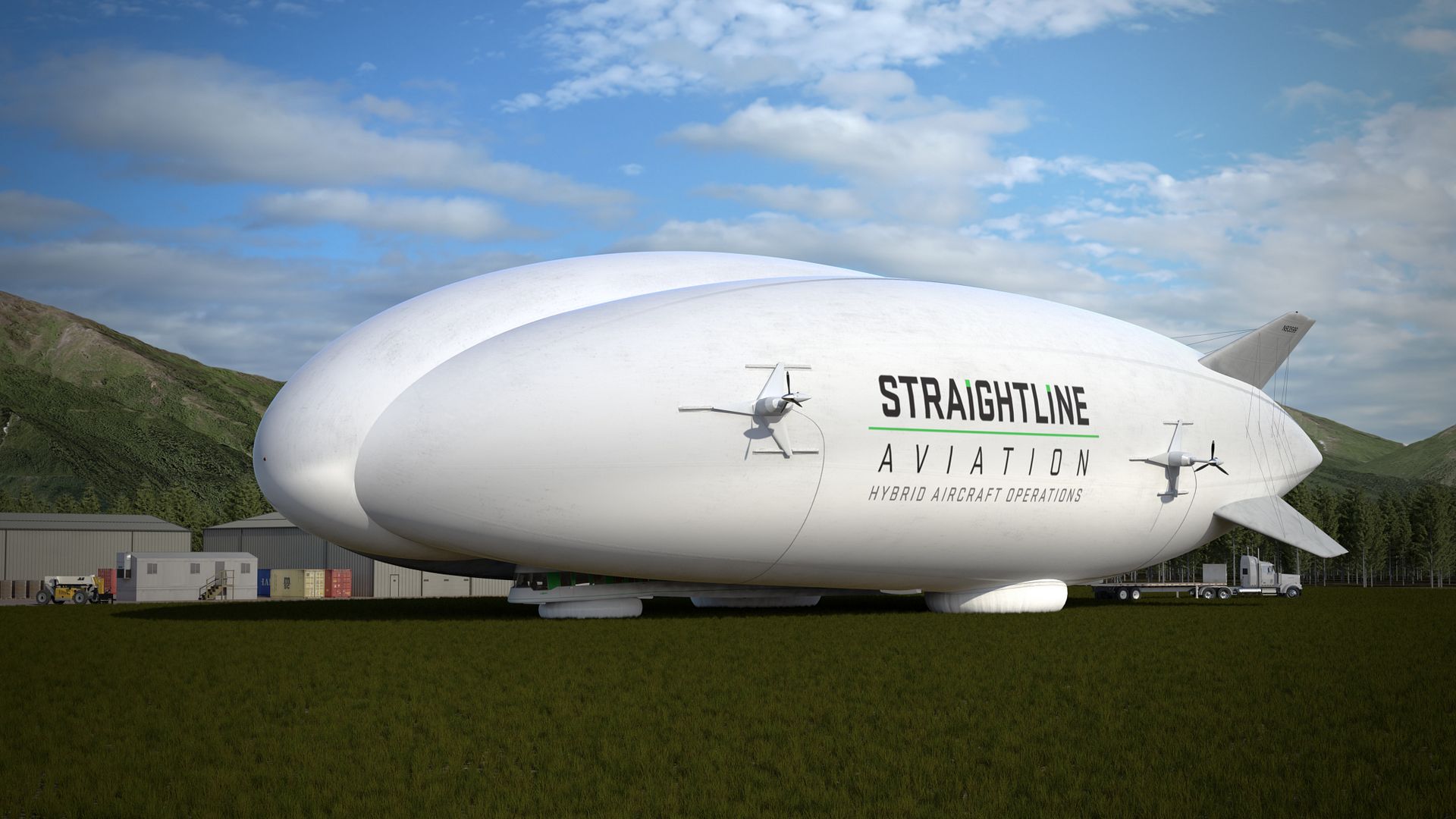
-
 Main AdminA C-27J Medium Range Surveillance airplane sits on the runway at Coast Guard Aviation Logistics Center in Elizabeth City, North Carolina, Thursday, March 31, 2016. The C-27J is the newest Coast Guard aircraft to join the fleet and will be used in maritime patrol, drug and migrant interdiction, disaster response, and search and rescue missions. U.S. Coast Guard photograph's by Chief Petty Officer NyxoLyno Cangemi
Main AdminA C-27J Medium Range Surveillance airplane sits on the runway at Coast Guard Aviation Logistics Center in Elizabeth City, North Carolina, Thursday, March 31, 2016. The C-27J is the newest Coast Guard aircraft to join the fleet and will be used in maritime patrol, drug and migrant interdiction, disaster response, and search and rescue missions. U.S. Coast Guard photograph's by Chief Petty Officer NyxoLyno Cangemi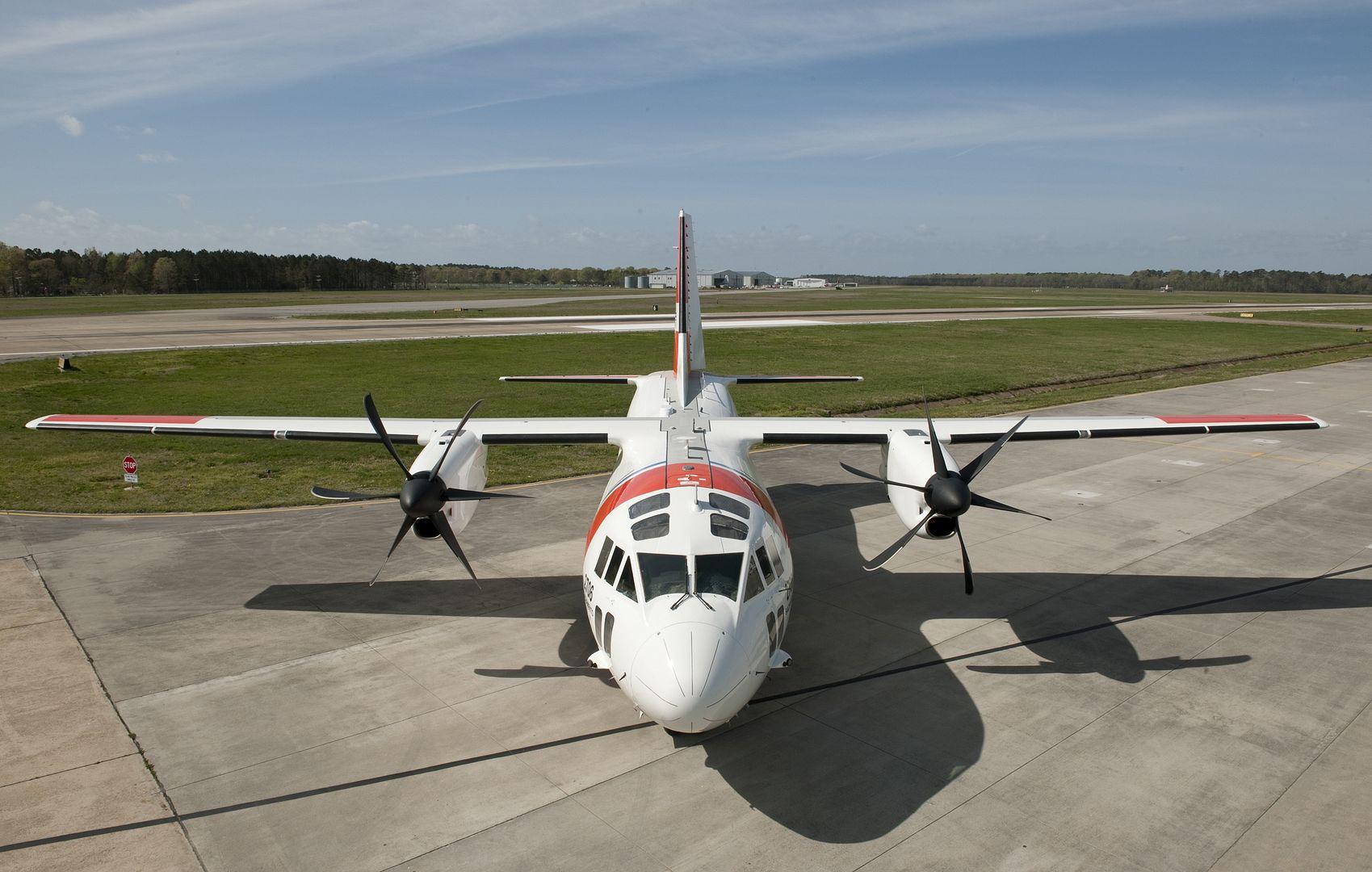
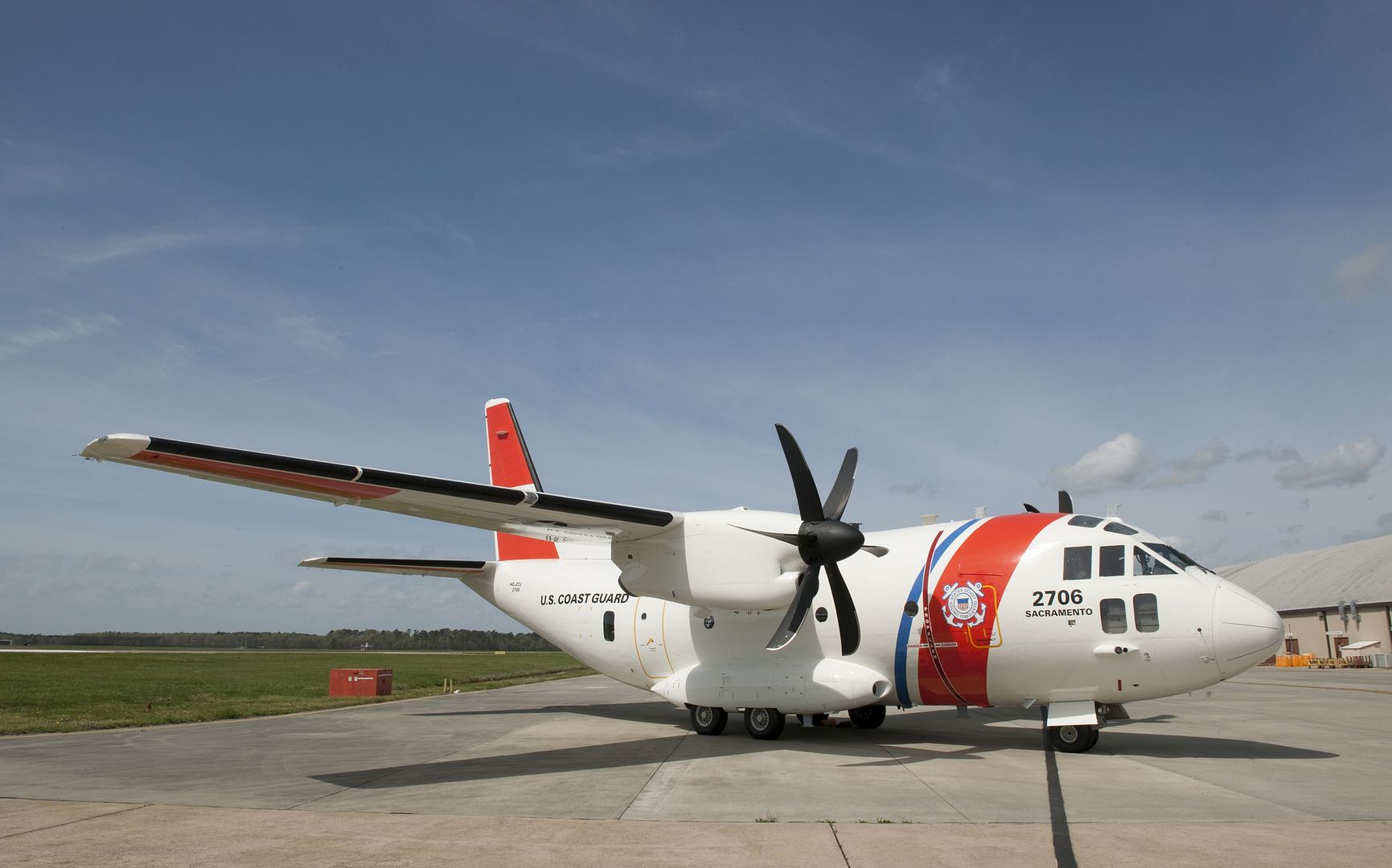
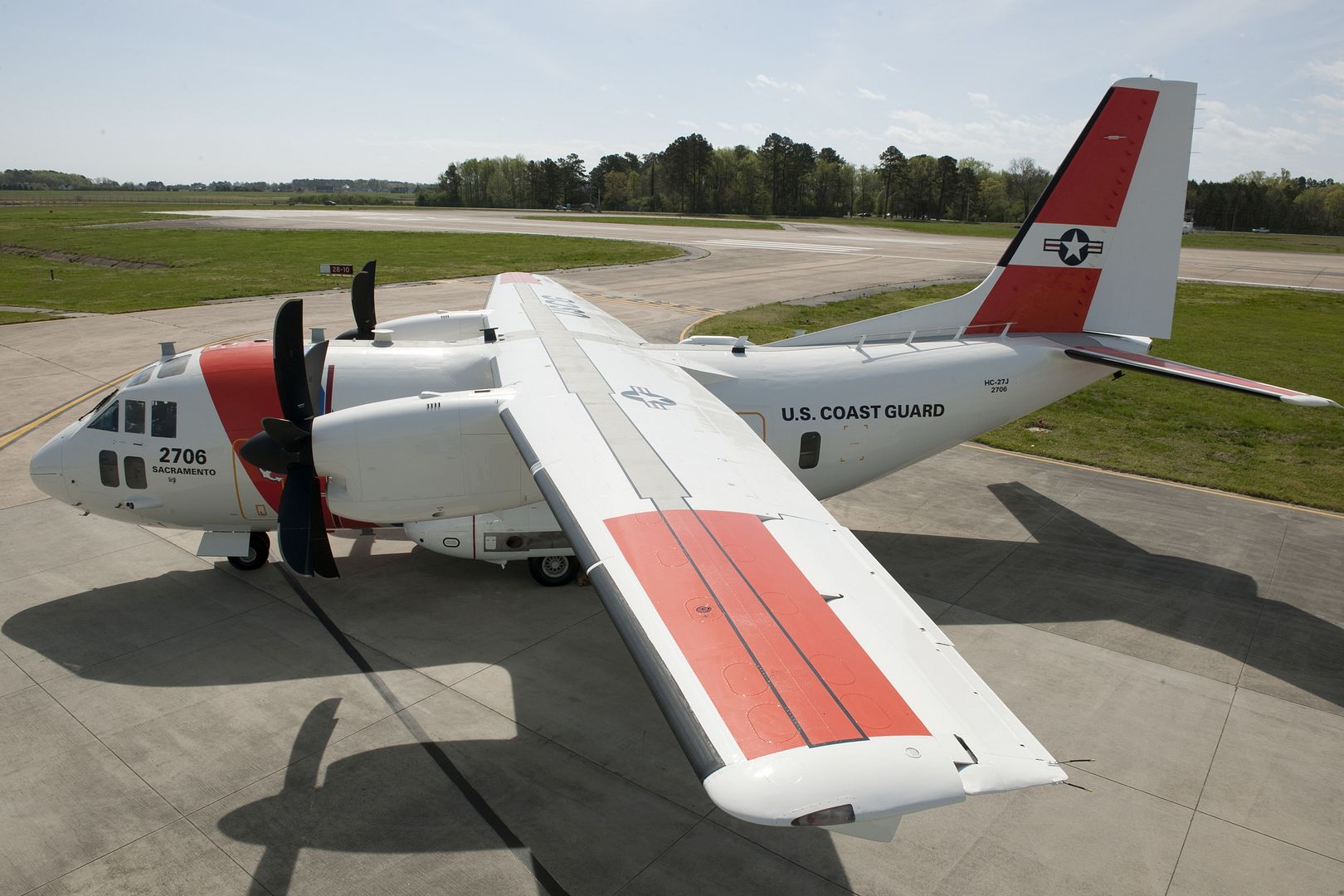
Fourteen KC-135 Stratotankers line up during a simulated alert call March 24, 2016, at McConnell Air Force Base, Kan. Known as the ?elephant walk,? the alert call was part of an exercise, which displayed the rapid mobility capabilities and teamwork of the men and women at McConnell AFB to take flight within minutes of being notified of a mission. (U.S. Air Force photos/Airman 1st Class Christopher Thornbury)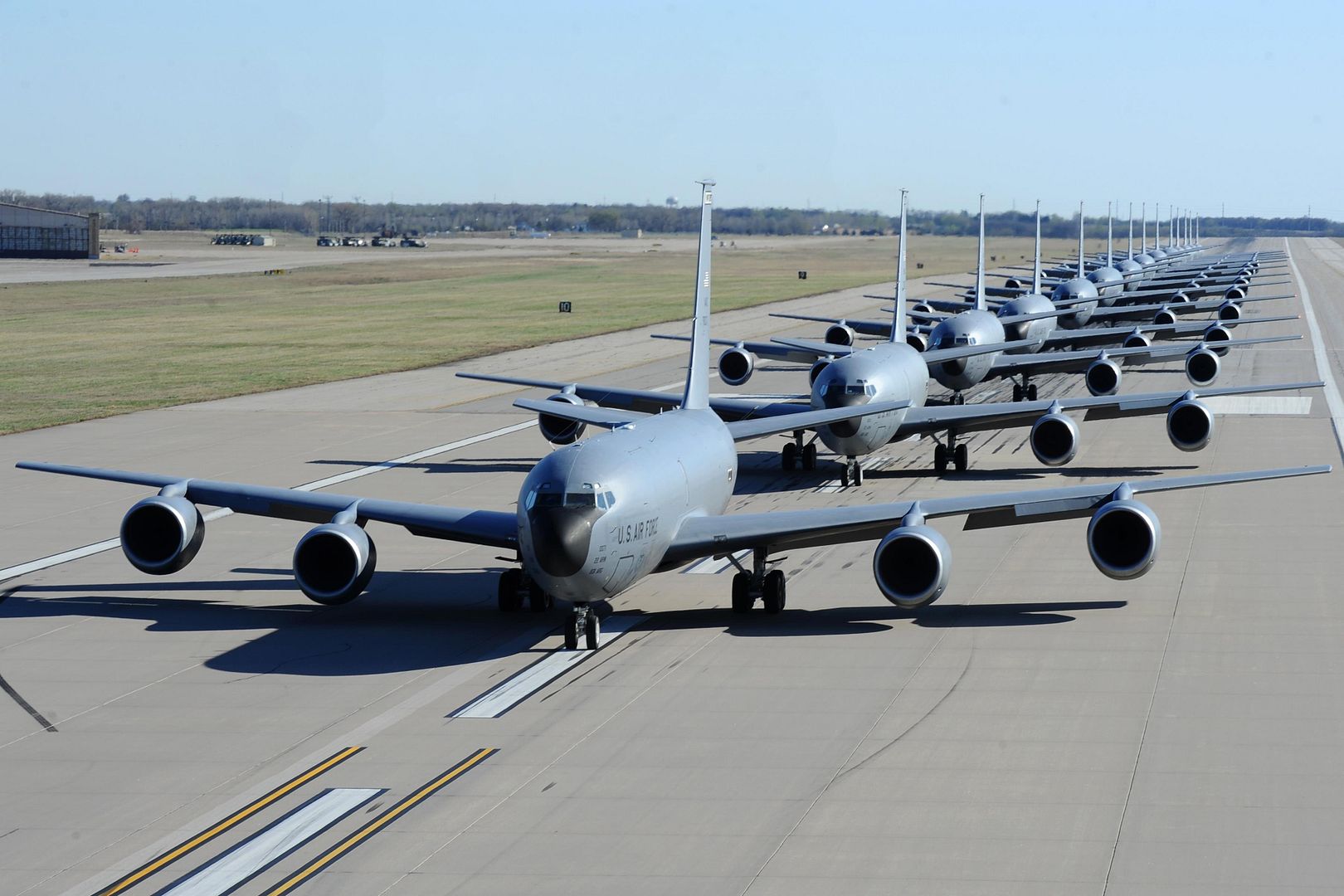
A B-2 Spirit, deployed from Whiteman Air Force Base, Mo., takes off March 27, 2016, in the U.S. Pacific Command area of operations. Bomber operations provide a visible demonstration of the U.S. Air Force's ability to project power globally and respond to any potential crisis or challenge. (U.S. Air Force photo/Senior Airman Joel Pfiester)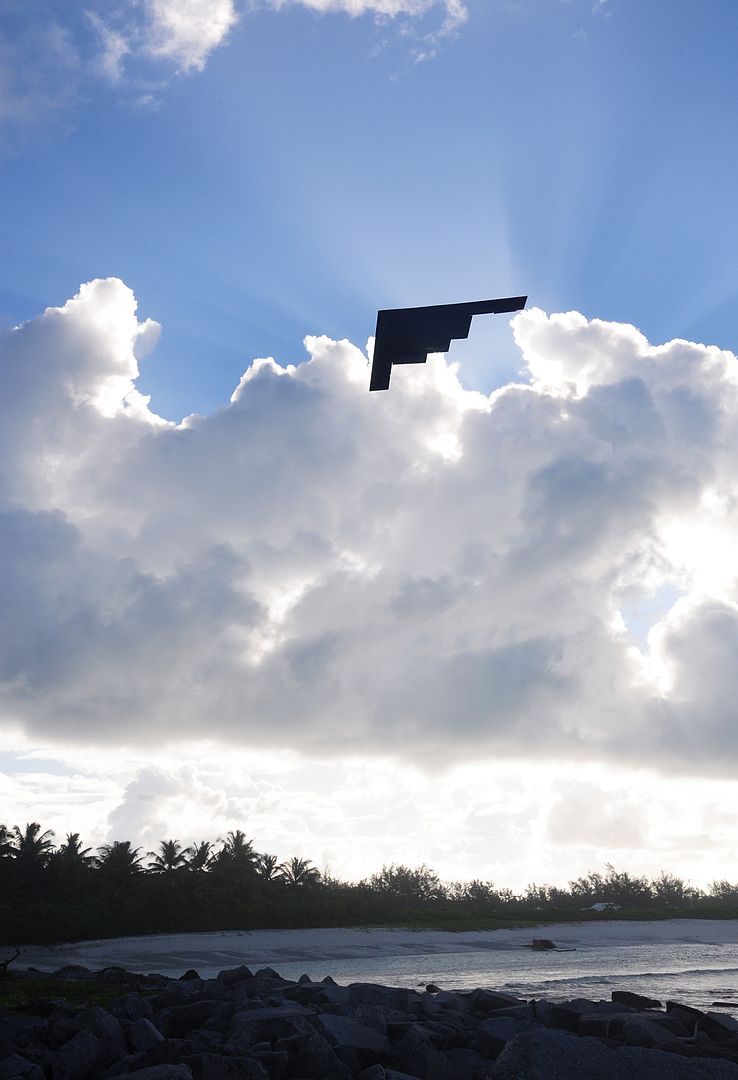
A KC-135 Stratotanker taxies to the runway at Al Udeid Air Base, Qatar, March 27, 2016. Ensuring aircraft take off safely is one of the many missions of the 379th Operations Support Squadron?s Airfield Management team. The team inspects the airfield every day, which includes more than 49 million square feet of pavement. Last year, the team supported more than 20,000 sorties. (U.S. Air Force photo/Tech. Sgt. James Hodgman)
-
 Main AdminEDWARDS AIR FORCE BASE, Calif. (AFNS) -- From testing synthetic biofuels to "vortex surfing," Edwards Air Force Base is on the forefront of finding new ways to cut fuel costs for the Air Force.
Main AdminEDWARDS AIR FORCE BASE, Calif. (AFNS) -- From testing synthetic biofuels to "vortex surfing," Edwards Air Force Base is on the forefront of finding new ways to cut fuel costs for the Air Force.
The latest venture is currently underway at the 418th Flight Test Squadron where a test team of Air Force and Boeing personnel recently completed the first phase of Air Force Research Laboratory's C-17 Drag Reduction Program.
According to an AFRL study, the price the Air Force pays for jet fuel has quadrupled between 2004 and 2012. At the same time, the demand for personnel and equipment to be transported around the world has increased. Airlifters like the C-17 Globemaster III, C-130 Hercules and C-5 Galaxy use most of the Air Force's fuel -- 70 percent in 2012. Of these cargo planes, the C-17 uses the most fuel.
The purpose of the C-17 Drag Reduction Program is to collect data on how airflow is affected with different modifications done to a C-17.
The modifications are scheduled for different phases using Vortex Control Technologies ?Finlets? and Lockheed Martin microvanes and fairings. The ultimate goal is to see which, if any, modification reduces drag and thus fuel consumption.
"The C-17 in one of the highest consumers of jet fuel in the Air Force," said Capt. Kevin Meyerhoff, a test pilot with the 418th Flight Test Squadron. "A reduction of just a few percent can result in significant cost savings."
The first phase consisted of putting six VCT Finlets on the aft part of the fuselage. The test aircraft for the program is a C-17 on loan from Joint Base Lewis-McChord, Washington.
Test sorties for Finlets 1 configuration were completed in March to determine how the C-17 performed with the modification.
Although the goal is to reduce fuel consumption by increasing airflow efficiency and reduce drag, it has to be done without negatively effecting what the C-17 can do now.
"The cost savings these devices may offer are entirely dependent on the C-17 still being able to fulfill its mission in the Air Force," Meyerhoff said. "Our testing focused not only on fuel performance, but also on any impacts that the devices may have on the flying qualities of the aircraft. This includes the C-17's ability to perform critical air drop missions."
The next phase of testing will add five more Finlets to each side of the C-17 for a total of 16 Finlets.
The strakes that come on production C-17s will be removed to make room for the additional Finlets.
In the third phase of testing, the Finlets will be removed and six microvanes will be placed on each side of the aft fuselage.
"The Finlets are similar to the strakes, only smaller and attached in greater numbers to the airplane. The microvanes are even smaller, similar to small plastic blades," said C-17 airdrop engineer Nhan Doan.
The fourth phase will see fairings attached to locations on the wings near the engines and winglets.
All these different structure modifications manipulate the airflow around the airplane. During computer simulations, spots on the C-17 were identified that showed where drag could be reduced.
The flight tests at Edwards AFB are the final stage of AFRL's program following computer simulations and wind tunnel tests with a scale model. The data collected will be sent to AFRL at Wright-Patterson Air Force Base, Ohio, to see if any of the modifications increase streamlining and reduce drag. After that, Air Force leaders will ultimately decide whether or not any of the modifications should be implemented throughout the C-17 fleet.
"Our end goal is to reduce fuel consumption while maintaining military utility" said Steve Salas, a 418th FLTS project manager. "This program has the potential for significant savings in C-17 fuel costs, helping the Air Force stretch its budget even further, while maintaining force readiness."
Testing is scheduled to be completed in October.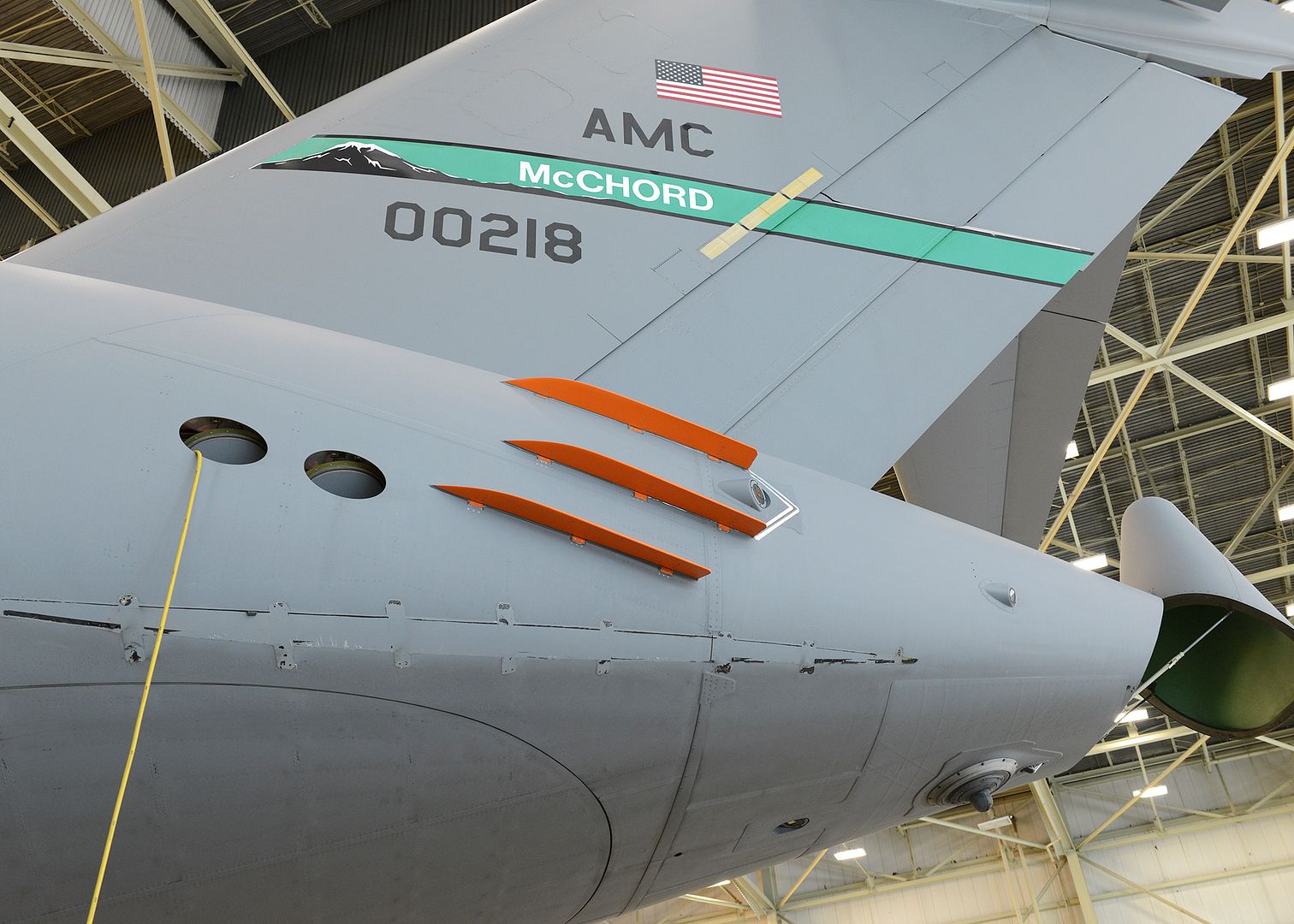
A C-17 Globemaster III takes off from Incirlik Air Base, Turkey, March 30, 2016. On March 29, 2016, the secretary of defense, in coordination with the secretary of state, ordered the departure of all Defense Department dependents assigned to Incirlik AB. (U.S. Air Force photo/Senior Airman John Nieves Camacho)
-
 Main AdminATLANTIC OCEAN (April 3, 2016) - An F/A-18E Super Hornet assigned to the Gunslingers of Strike Fighter Squadron (VFA) 105 prepares to make an arrested landing on the flight deck of the aircraft carrier USS Dwight D. Eisenhower (CVN 69), the flagship of the Eisenhower Carrier Strike Group. Ike is underway conducting a Composite Training Unit Exercise (COMPTUEX) with the Eisenhower Carrier Strike Group in preparation for a future deployment. (U.S. Navy photo by Mass Communication Specialist 3rd Class Michael R. Gendron/Released)
Main AdminATLANTIC OCEAN (April 3, 2016) - An F/A-18E Super Hornet assigned to the Gunslingers of Strike Fighter Squadron (VFA) 105 prepares to make an arrested landing on the flight deck of the aircraft carrier USS Dwight D. Eisenhower (CVN 69), the flagship of the Eisenhower Carrier Strike Group. Ike is underway conducting a Composite Training Unit Exercise (COMPTUEX) with the Eisenhower Carrier Strike Group in preparation for a future deployment. (U.S. Navy photo by Mass Communication Specialist 3rd Class Michael R. Gendron/Released)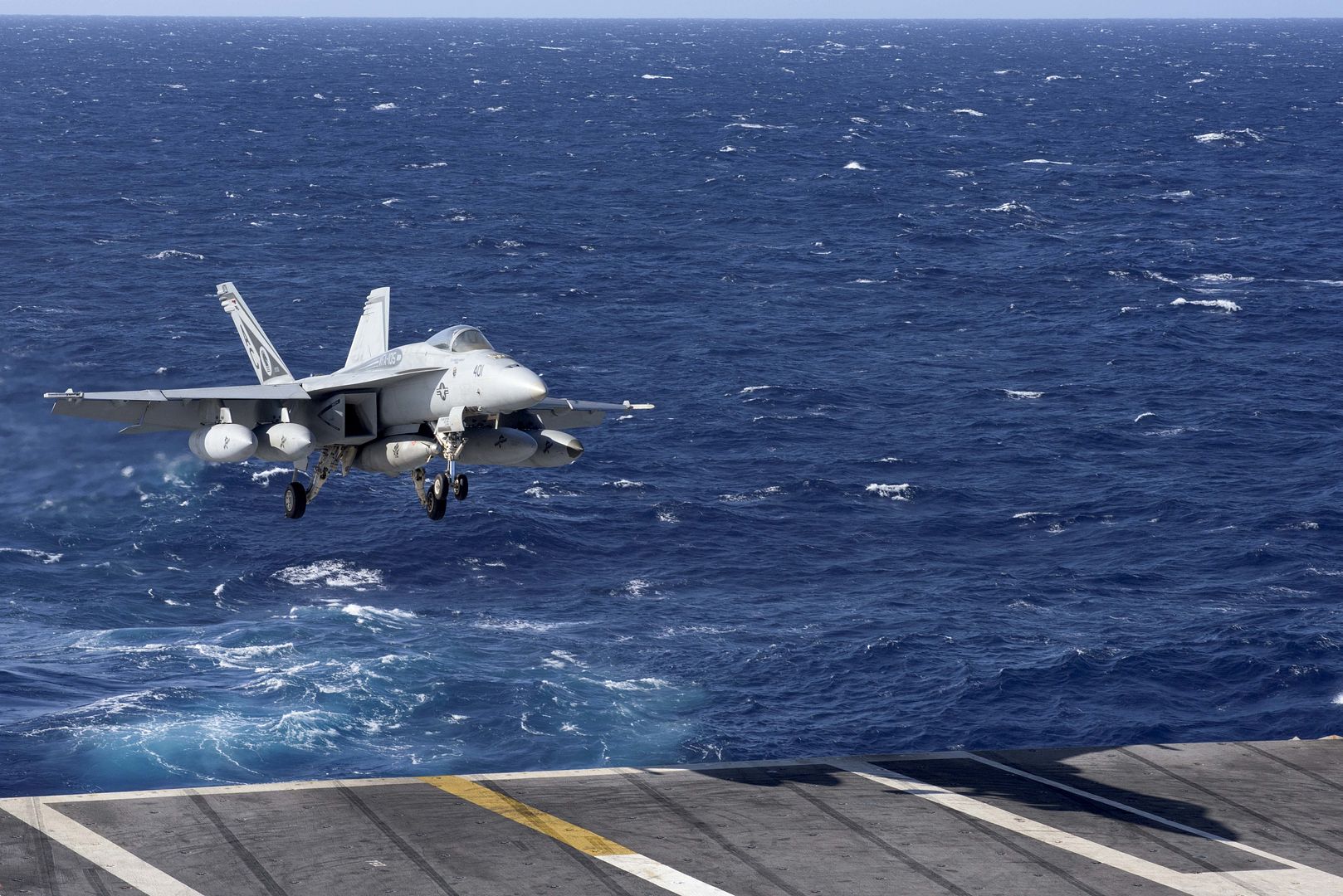
Barnes Air National Guard Base, Mass. - Over 200 unit members from the 104th Fighter Wing and 12 F-15 Eagle aircraft are deploying this week to support multiple NATO objectives in Europe. While deployed, the unit will conduct training alongside our NATO allies and partners to strengthen interoperability (Air National Guard photo by Senior Airman Loni Kingston).
Barnes Air National Guard Base, Mass. - Pilot Lt. Col. Ken Fedora prepares for takeoff as more than 200 unit members from the 104th Fighter Wing and 12 F-15 Eagle aircraft deploy this week to support multiple NATO objectives in Europe. While deployed, the unit will conduct training alongside our NATO allies and partners to strengthen interoperability (Air National Guard photo's by Senior Airman Loni Kingston).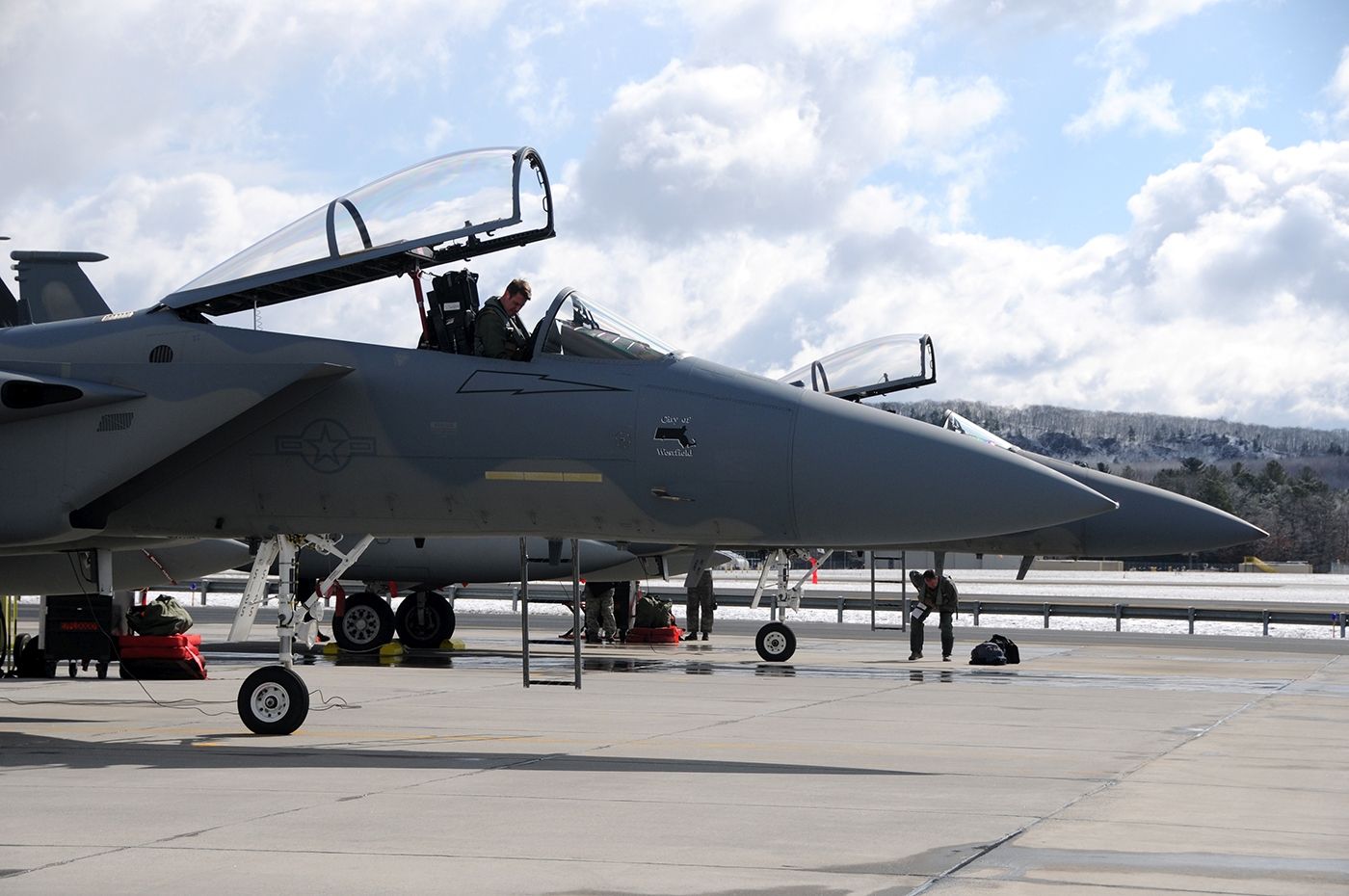
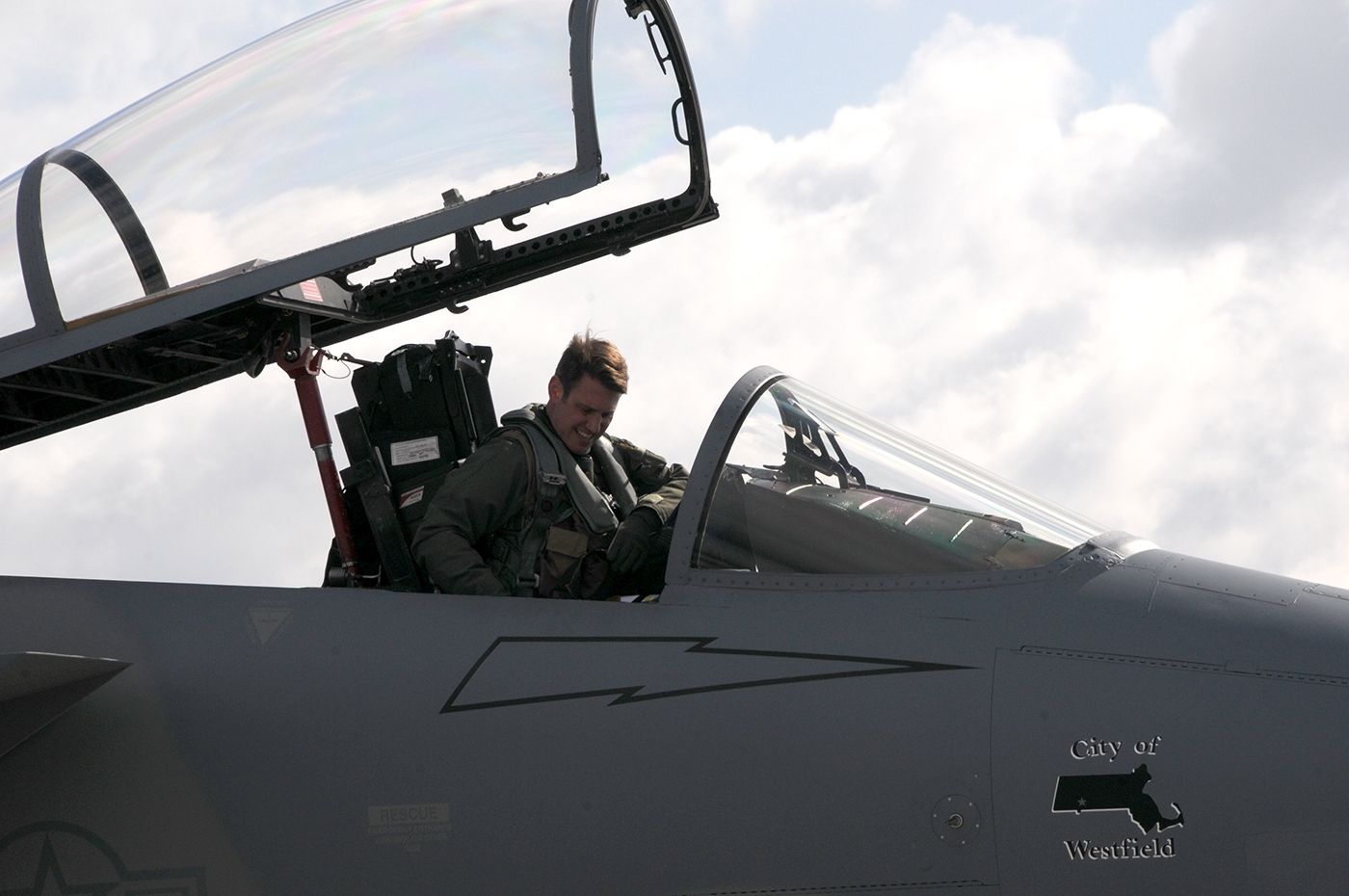
SEATTLE, April 4, 2016 /PRNewswire/ -- Boeing (NYSE: BA) and Ryanair marked a milestone today with the delivery of the airline's 400th Next-Generation 737-800.
Ryanair celebrates delivery of low-cost carrier's 400th Next-Generation 737-800
The Irish low-cost carrier operates the largest fleet of Next-Generation 737-800s in the world.
"The Boeing 737-800 aircraft, with its industry leading technical reliability and seating capacity, has been the foundation upon which our successful and safe growth has been built upon, since we took our first delivery in March 1999," said Ryanair's Chief Operations Officer, Michael Hickey. "We are delighted to be now taking delivery of our 400th 737-800, which includes the new Boeing Sky Interior and slimline seats, offering extra leg room and an enhanced customer experience, as part of our 'Always Getting Programme'."
Ryanair pioneered the low-cost model in Europe more than 30 years ago, with the Next-Generation 737-800 providing the optimal platform for its continued growth. Ryanair is the largest Boeing operator in Europe with more than 1,800 daily flights carrying 106 million passengers annually to more than 30 countries.
"A key factor in Ryanair's continued success is the outstanding economics of the Next-Generation 737-800," said Monty Oliver, vice president, European Sales, Boeing Commercial Airplanes. "This 400th 737 delivery is a special milestone for both our companies and we are honored that Ryanair continues to be an all-Boeing operator."
Ryanair has more than 130 unfilled orders for Next-Generation 737-800s and is also the launch customer for the 737 MAX 200, the newest member of the 737 MAX family.
The Dublin-based carrier ordered 100 737 MAX 200s, a variant based on the successful 737 MAX 8, that can accommodate up to 200 seats, increasing revenue potential and providing airlines with up to 20 percent better fuel efficiency per seat than today's most efficient single-aisle airplanes.
-
 Main AdminWASHINGTON (AFNS) -- Eielson Air Force Base, Alaska, was selected as the new home for the Air Force?s first operational overseas F-35A Lightning IIs.
Main AdminWASHINGTON (AFNS) -- Eielson Air Force Base, Alaska, was selected as the new home for the Air Force?s first operational overseas F-35A Lightning IIs.
Air Force officials chose Eielson AFB after a lengthy analysis of the location?s operational considerations, installation attributes, environmental factors and cost.
?Alaska combines a strategically important location with a world-class training environment. Basing the F-35s at Eielson AFB will allow the Air Force the capability of using the Joint Pacific Alaska Range Complex (JPARC) for large force exercises using a multitude of ranges and maneuver areas in Alaska,? said Secretary of the Air Force Deborah Lee James. "This, combined with the largest airspace in the Air Force, ensures realistic combat training for the (Defense Department).?
Proximity to the JPARC will enable the Air Force to take advantage of approximately 65,000 square miles of available airspace for realistic, world-class training in the Air Force?s most advanced fifth-generation fighter.
The decision culminates a three-year process that included an extensive environmental impact statement that examined impacts on such factors as air quality, noise, land use and socioeconomics.
"The decision to base two F-35 squadrons at Eielson AFB, Alaska, combined with the existing F-22 Raptors at Joint Base Elmendorf-Richardson, will double our fifth-generation fighter aircraft presence in the Pacific theater," said Air Force Chief of Staff Gen. Mark A. Welsh III. "Integrating that fifth-generation force with Navy, Marine, and allied F-35 forces will provide joint and coalition warfighters unprecedented survivability, lethality and battlespace awareness in contested environments. It's an exciting time for Pacific airpower."
The base is projected to receive two squadrons of F-35As, which will join the wing?s F-16 Fighting Falcon aggressor squadron currently assigned to Eielson AFB.
On-base construction to prepare for the aircraft is expected to start in fiscal year 2017 in order to be ready to accept the first F-35As, which are currently scheduled to begin arriving in 2020.
Preliminary estimates had the new aircraft arriving a year earlier, but officials say the 2020 arrival will provide the Air Force more time and grow its active-duty maintenance force.
?The Air Force is facing a shortage of experienced, active-duty fighter aircraft maintainers as we transition from legacy aircraft to the F-35A,? said Lt. Gen. John B. Cooper, the deputy chief of staff the Air Force for logistics, installations and mission support. ?Adjusting the initial plan and slightly accelerating F-35A arrivals at Burlington Air Guard Station, Burlington, Vermont, to fall 2019 will allow the service to stick to the overall F-35 rollout schedule, while capitalizing on the Air National Guard?s experienced fighter aircraft maintenance force as we put additional measures in place to increase the number of trained active-duty maintainers.?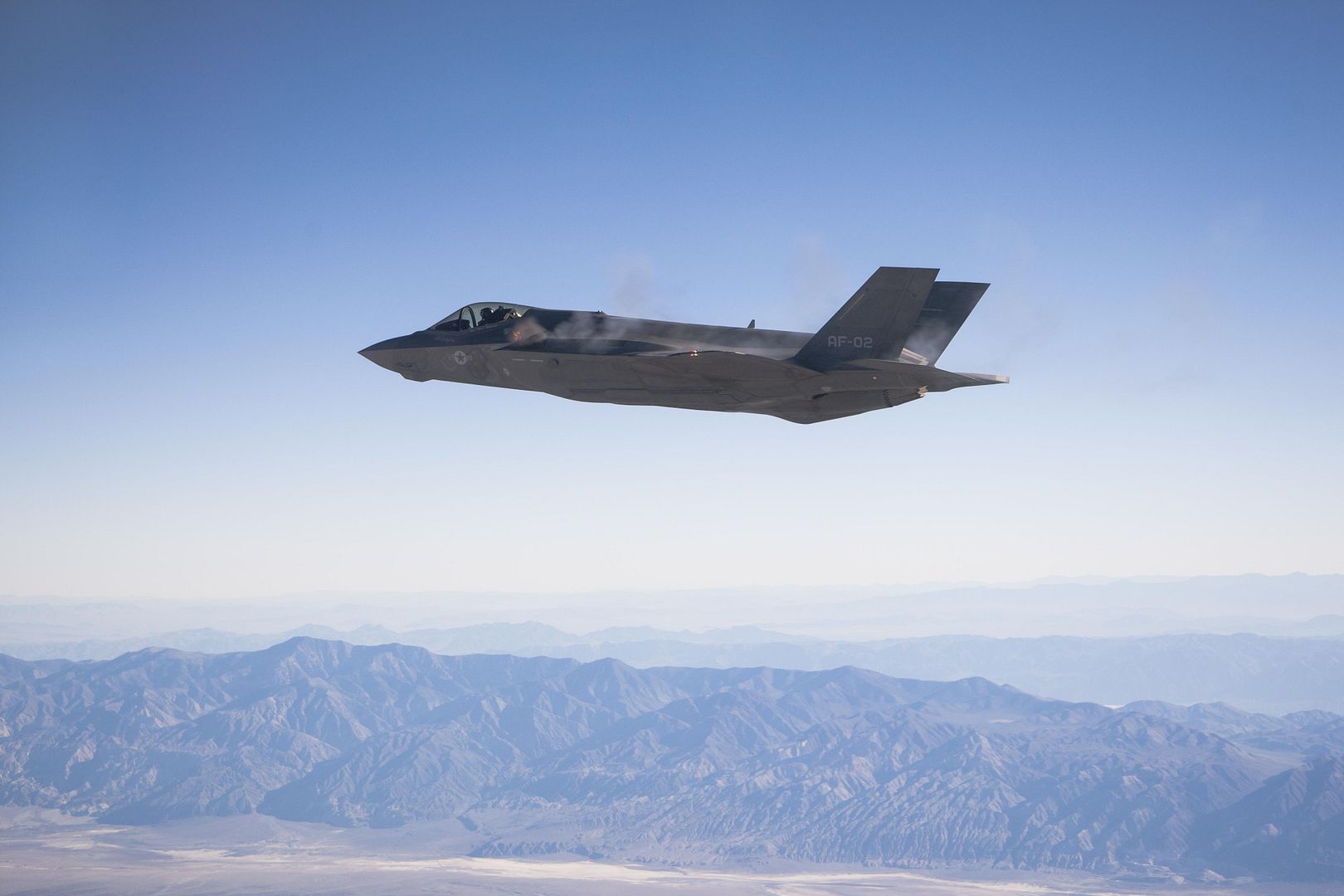
4 April 2016 Press Release
Painting of the first U.S.-built American Airlines Airbus A321 has been completed. The aircraft has left the paint shop at the Airbus U.S. Manufacturing Facility in Mobile, Alabama.
The aircraft is the second A321 to be produced in the Airbus U.S. Manufacturing Facility in Mobile, but the first for American Airlines. There are currently eight aircraft in production for American Airlines at the facility.
The aircraft painting was achieved by MAAS Aviation. The company is responsible for painting aircraft in its new facility located on the Mobile Aeroplex at Brookley within the Airbus manufacturing facility campus.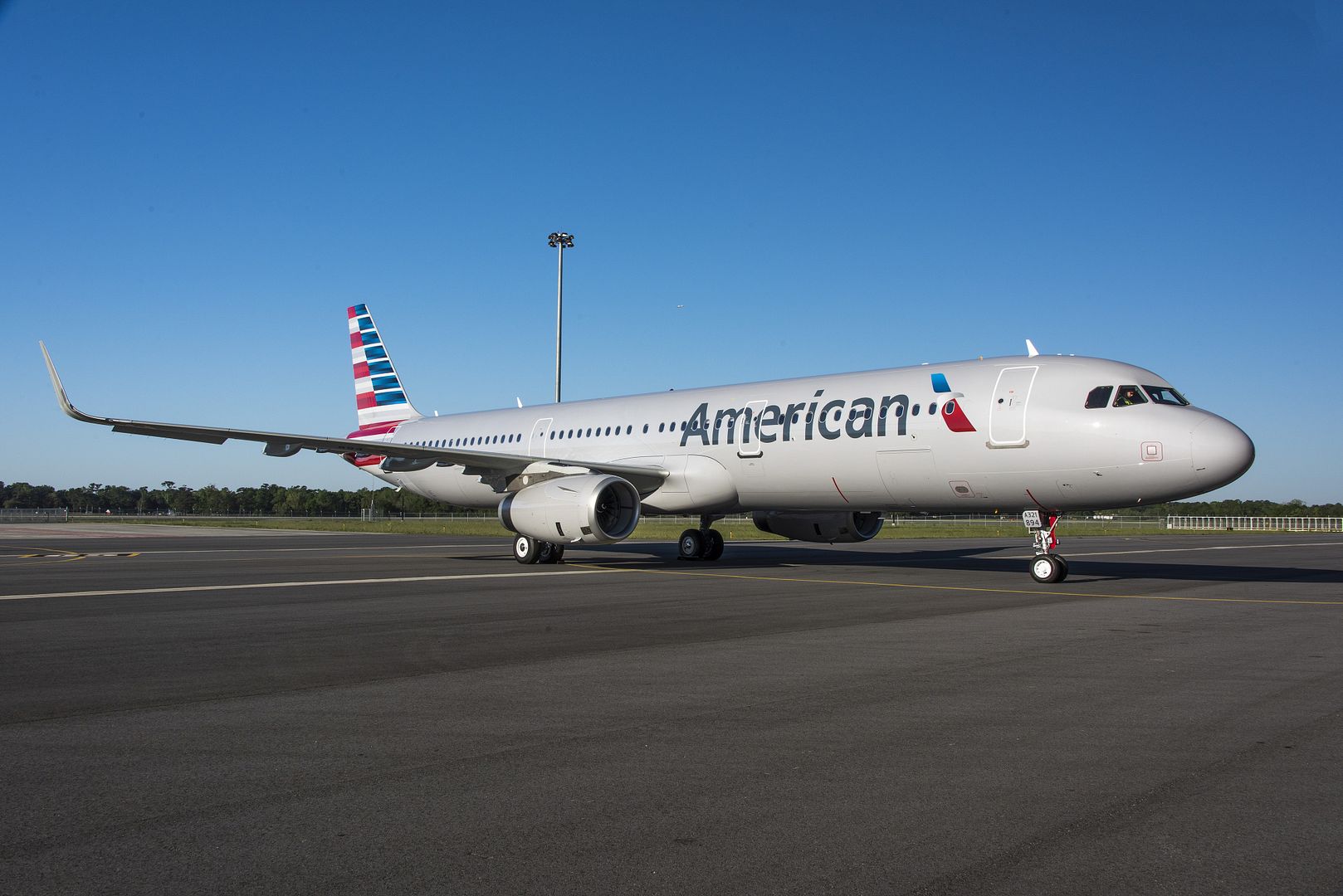
-
9 years agoWed Apr 06 2016, 10:59am
 Main AdminDOVER AIR FORCE BASE, Del. (AFNS) -- They are hot, bright and a visual spectacle. But they are not your run-of-the-mill fireworks being shot off in celebration. Flares used by pilots are life-saving emergency countermeasures that keep Dover Air Force Base aircraft in the skies delivering airlift cargo to the warfighter.
Main AdminDOVER AIR FORCE BASE, Del. (AFNS) -- They are hot, bright and a visual spectacle. But they are not your run-of-the-mill fireworks being shot off in celebration. Flares used by pilots are life-saving emergency countermeasures that keep Dover Air Force Base aircraft in the skies delivering airlift cargo to the warfighter.
Flares play a pivotal role keeping Dover's C-5M Super Galaxies and C-17A Globemaster IIIs from being shot down while conducting combat operations downrange. Flares protect aircraft by forcing infrared threats, such as heat-seeking, surface-to-air or air-to-air missiles, to lock onto their heat signatures rather than the aircraft's engine.
Each aircraft is loaded with various types of flares depending on mission, location and requirements. Flares are either punched out automatically by the aircraft's electronic countermeasure systems or they can be manually jettisoned by aircraft pilots. But flares go through various stages before meeting their blistering end.
Staff Sgt. John Judy, a 436th Maintenance Squadron munitions inspector, oversees flare operations within the ammo section at Dover AFB. Judy, along with other ammo Airmen, build flare sets specific to each aircraft and mission.
"Part of our mission is to keep the C-5 and C-17 aircraft replenished with good flares," Judy said. "That way when they fly into combat, they have something to defend themselves with."
After the flare sets are assembled, strict protocols are taken to deliver the flares to the flightline where they are uploaded onto the aircraft by trained Airmen from the 436th and 736th Aircraft Maintenance Squadrons. It takes at least three qualified personnel to conduct flare uploading or downloading operations, two personnel handling the flares and one safety observer.
Staff Sgt. Matthew Calvo, a 736th AMXS communication, countermeasure and navigation system craftsman, ensures that flares are properly and safely loaded onto C-17s. Calvo also ensures that the aircraft's countermeasure dispensing system is functioning properly so flares are guaranteed to dispense from the aircraft when needed.
"The purpose of the countermeasure dispensing system is to defeat infrared threats," Calvo said. "The threats are defeated by manually punching out flares or if the system is interfaced with an active electronic countermeasure system, such as the missile warning system or infrared countermeasure system, that system would then punch out flares automatically according to the threat."
Both C-17 and C-5 onboard computers are uploaded with specific mission data that tell the computer what kind of threats the aircraft is likely to face based on the location of the mission. If the aircraft comes under fire, the computer registers the threat and based off of factors such as the threat's temperature and speed, the aircraft will automatically dispense the appropriate flares that have the best chance of defeating that specific threat.
Most flares that are dispensed from aircraft at Dover AFB are from controlled training missions. Aircrews from the 9th and 3rd Airlift Squadrons routinely fly over the Bollen Live-Fire Range Complex on Fort Indiantown Gap, Pennsylvania, where simulated surface-to-air missiles, or smokey SAMs, are fired at the aircraft to test the aircraft's countermeasure systems.
First Lt. Taylor Warren, a 3rd AS pilot, recently flew her first training mission over Bollen Range. Warren and other aircrew members made eight passes through the range, encountering smokey SAM threats with each pass.
"They were shooting different things at us from different sides of the aircraft," Warren said. "We had some front aspect shots, we had some shots from the three-to-nine line and even some rear aspect shots. So we got to see the different ways the jet's defensive systems reacted to those threats."
As the smokey SAMs were shot at the Dover C-17, the countermeasure system responded by punching out the most likely flare to defeat the threat, allowing the pilots to focus on threat and escape maneuvers. Warren said the training has increased her confidence in her abilities to recognize and respond to threats in an efficient, timely manner.
"The most important thing I've learned as a new co-pilot is what the flares actually sound like when they go off," Warren said. "Now I will know if I heard them and I don't need to hit the button or I didn't hear them and we are getting a missile launch warning that I need to punch the button myself."
Some Dover pilots have had flares punch out from their aircraft while in a combat theater.
Last year, 1st Lt. Tristin Everett, a 9th AS pilot, was the acting co-pilot of a C-5M taking off from Bagram Airfield, Afghanistan, when flares suddenly shot out from the aircraft.
?The takeoff seemed pretty normal,? Everett said. ?After about 1,000 or 1,500 feet or so, we started making our turn and then we heard this loud thud. It was just like a kick in the pants and the flares started dispensing."
Although there was never a clear confirmation that the aircraft actually came under fire, Everett said he was thankful the flares did their job at neutralizing any potential threat.
"It was one of those moments you can't forget and it makes the hair stand up on the back of your neck," Everett said. "I am definitely thankful for the maintenance and everything that goes into keeping the aircraft and defense systems working like it should."
For the maintainers at Dover AFB, Airmen know why their job of uploading flares is crucial in saving lives.
"Everything we do out here on the flightline we take pride in," Calvo said. "It definitely feels good when you work with flares because you know the aircraft, aircrew and everything onboard is safe. We are helping these aircraft be safer when they are down range performing the mission and that's something we take a lot of pride in."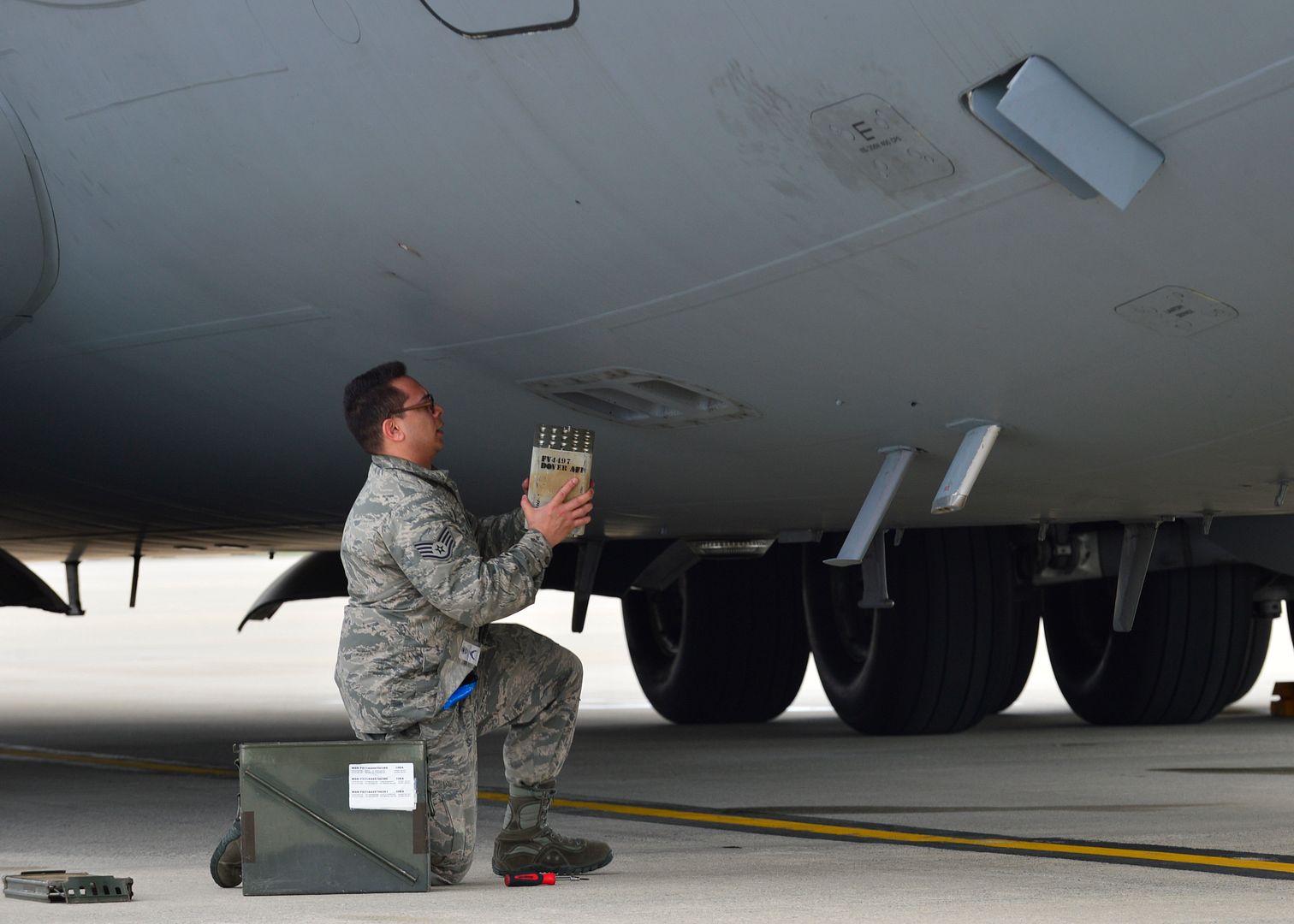
Staff Sgt. Matthew Calvo, a 736th Aircraft Maintenance Squadron communication, countermeasure and navigation system craftsman, uploads a flare magazine onto a C-17A Globemaster III on March 25, 2016, at Dover Air Force Base, Del. Each magazine consists of different flare sticks that are capable of defeating different infrared threats. (U.S. Air Force photo/Senior Airman William Johnson)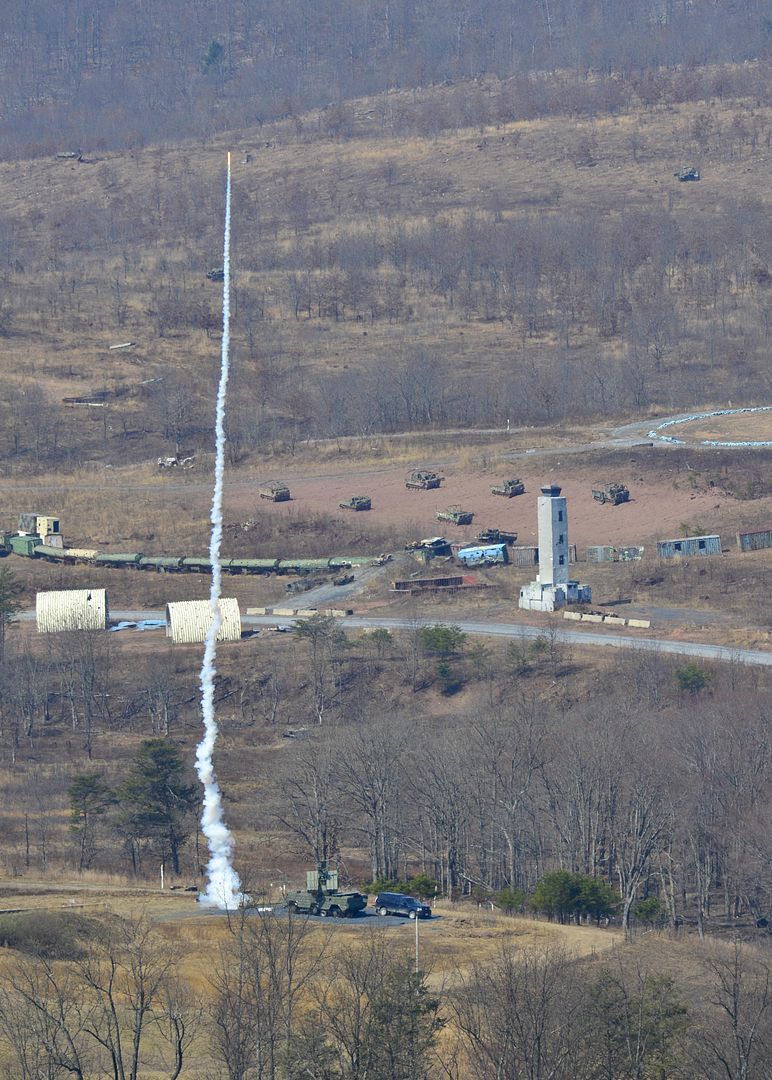
A training surface-to-air missile, or smokey SAM, is shot from a Man-Portable Aircraft Survivability Trainer system at a C-17A Globemaster III from Dover Air Force Base during a training mission March 24, 2016, at the Bollen Live-Fire Range Complex on Fort Indiantown Gap, Pa. A total of eight smokey SAMs were shot at the C-17 to test the aircraft?s electronic countermeasure systems. (U.S. Air Force photo/Senior Airman William Johnson)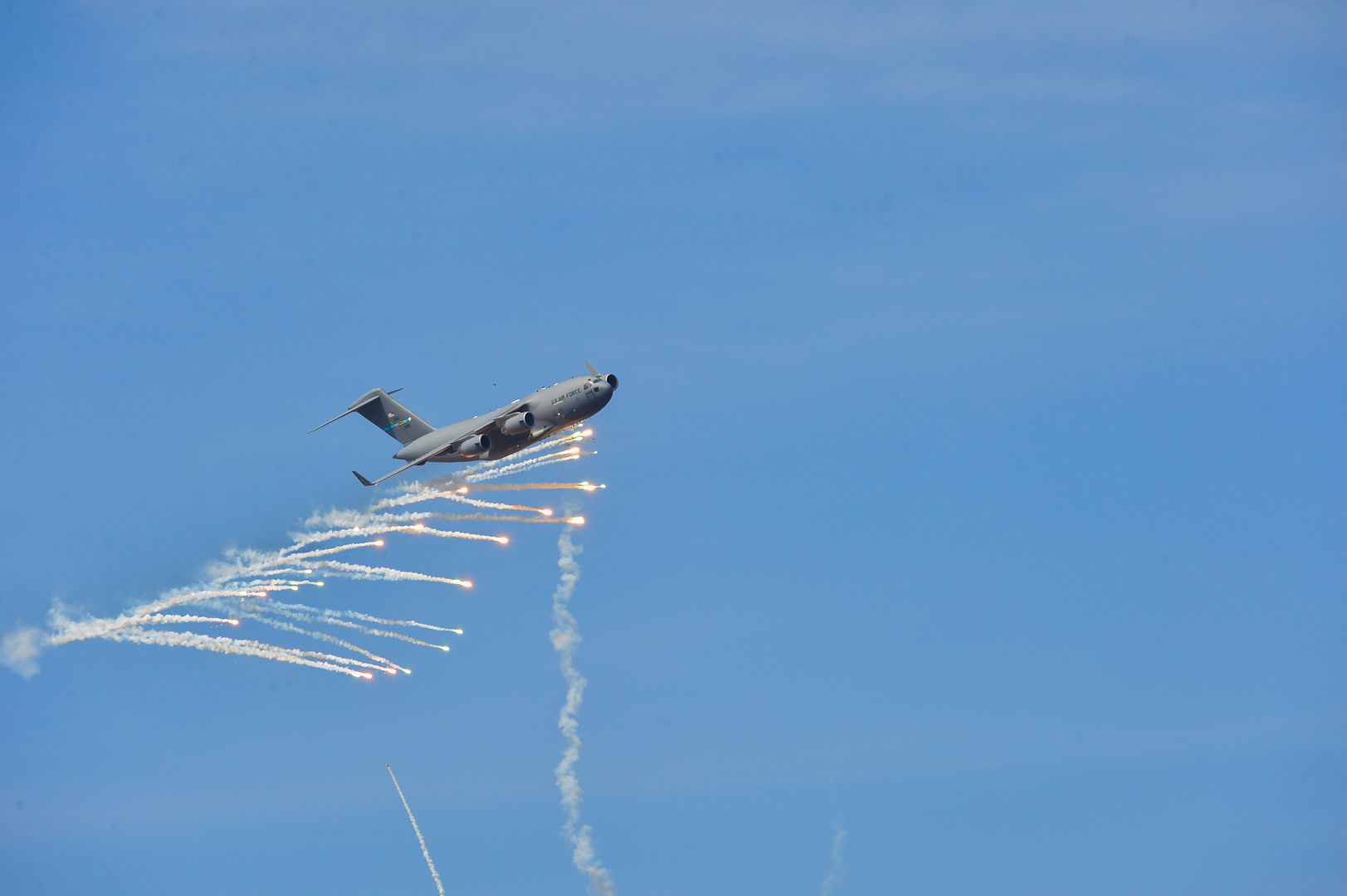
A C-17A Globemaster III from Dover Air Force Base, Del., expends countermeasure flares to defeat a simulated surface-to-air missile shot from a Man-Portable Aircraft Survivability Trainer system during a training mission March 24, 2016, at the Bollen Live-Fire Range Complex on Fort Indiantown Gap, Pa. A total of 240 flares were expended from the aircraft during the training mission. (U.S. Air Force photo/Senior Airman William Johnson)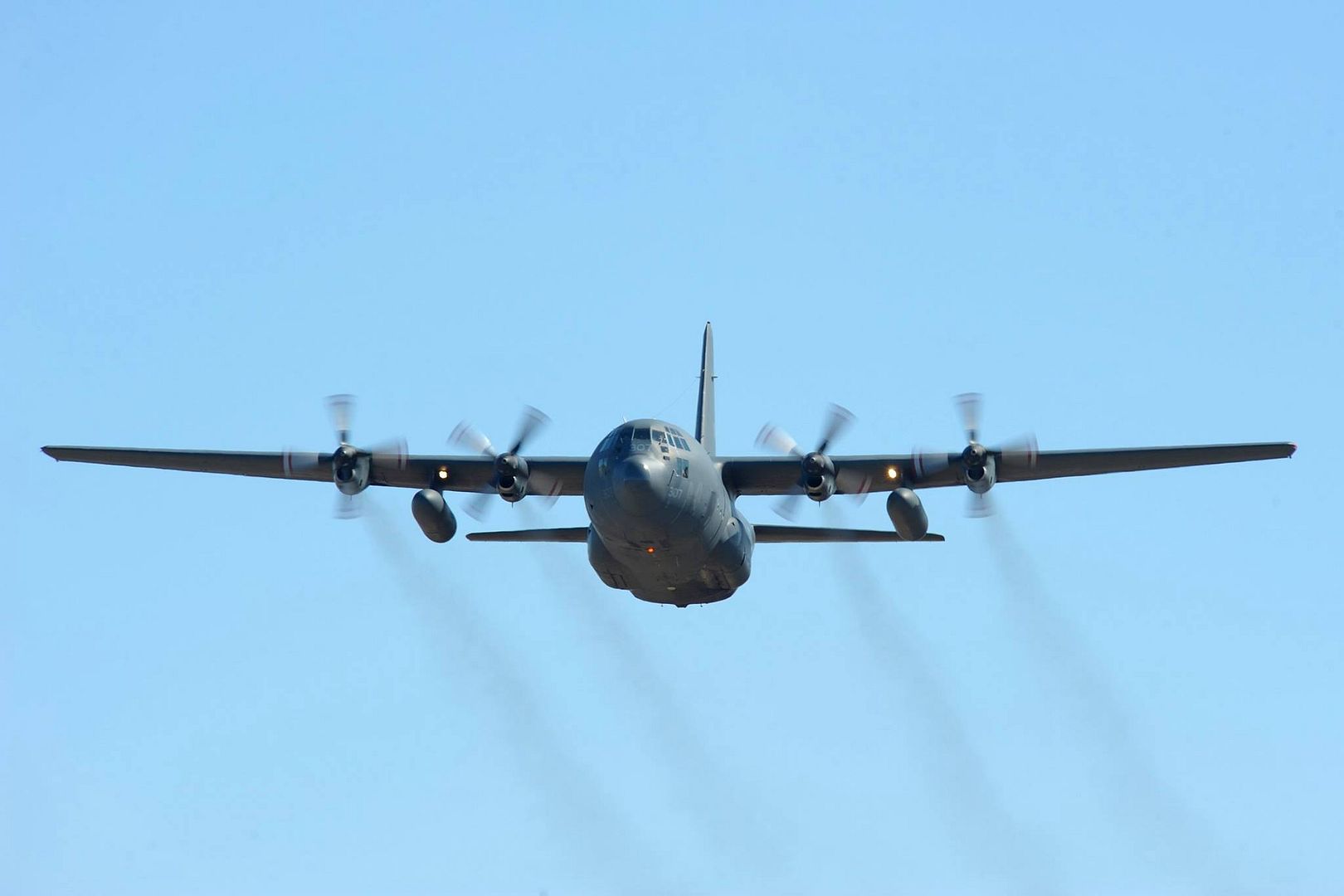
The Royal Canadian Air Force's final CC-130 E Hercules Legacy aircraft was retired and donated to the Canada Aviation and Space Museum to become part of its permanent collection, Tuesday, April 5, 2016 in Ottawa. The aircraft made its final flight from 8 Wing Trenton to the museum where it was handed over in a ceremony with RCAF Commander, Lieutenant-General Michael Hood.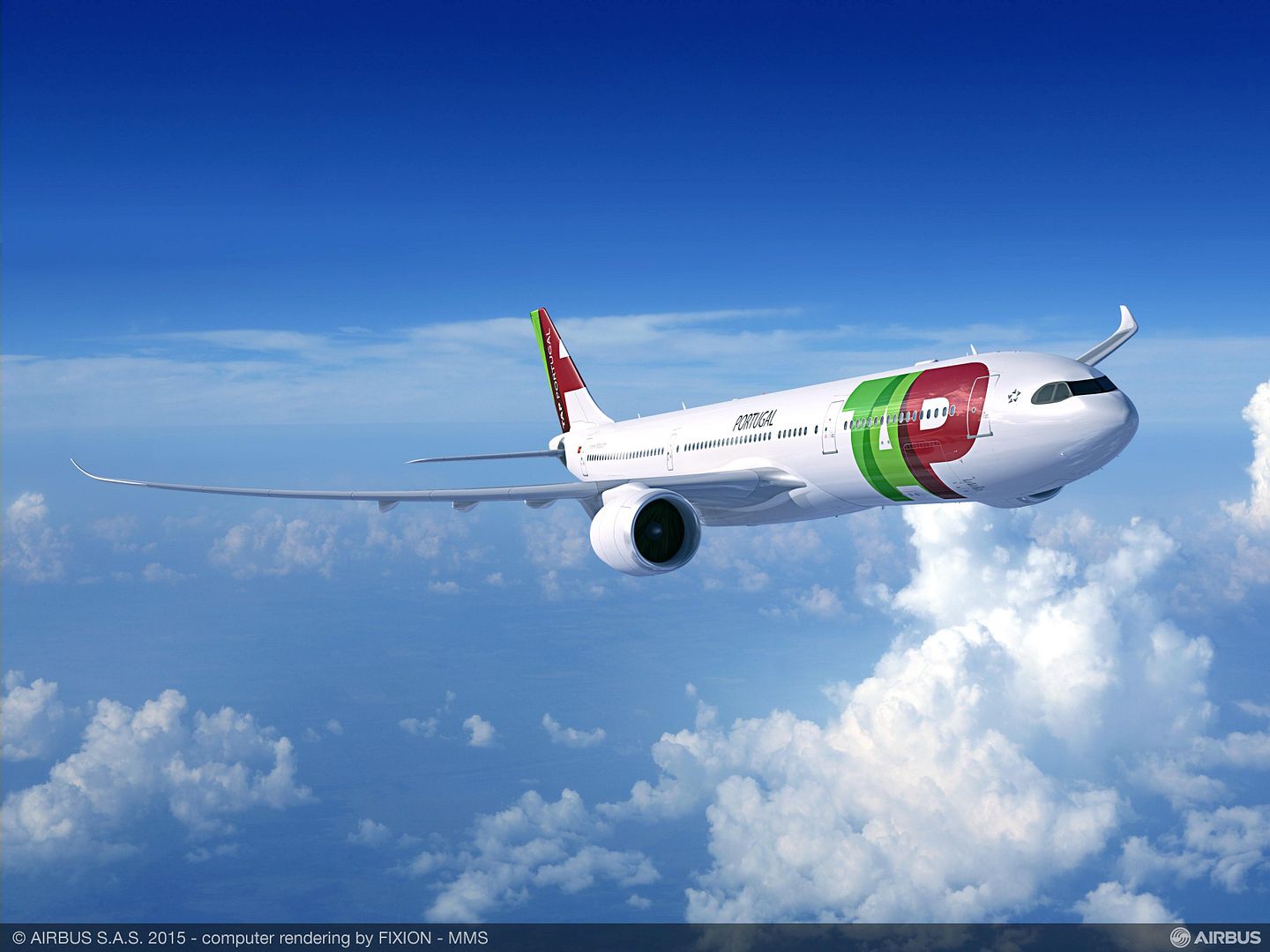
6 April 2016 Press Release
Aircraft Interiors Expo (AIX) 2016 ? TAP Portugal has signed an agreement with Airbus to be the first operator of the new A330neo airliner and therefore also become the launching carrier to fly the Airspace by Airbus cabin brand in the A330neo. In 2015, the airline placed a large fleet renewal contract with Airbus which included an order for 14 A330-900neos. Passengers will soon be able to experience the Airspace by Airbus cabin for the first time when these aircraft enter service around the end of 2017.
Trey Urbahn, Chief Commercial Officer at TAP Portugal said: ?We are extremely proud to be the first airline to fly the Airspace by Airbus cabin in the new A330neo. Our passengers and flight-crews eagerly look forward to experiencing this innovative new cabin design. Furthermore, the Airspace cabin represents an exciting and flexible canvas onto which we can project the TAP brand.?
Fran?ois Caudron, Senior Vice President of Marketing at Airbus said: ?We are delighted to confirm that TAP will become the first airline to introduce the Airspace by Airbus cabin in the A330neo. Developed with passengers at heart and airlines in mind, Airspace encompasses four pillars: Comfort, Ambience, Services and Design and will ensure that Airbus cabins continue to be the benchmark in passenger experience and airline value.?
Highlights of TAP?s Airspace cabin will include: a new welcome area; the latest mood LED-based lighting system with 16.7 million possible colour variations; larger overhead bins; new contemporary lavatories and latest-generation IFE and connectivity. The Airspace cabin ambience ensures passengers? wellbeing, while the signature details and iconic elements will be recognisable throughout the cabin.
The relationship between Airbus and Portugal dates back to 1987 when TAP, then Air Portugal, ordered three Airbus A310s. Today TAP is an all Airbus fleet customer and the largest in Portugal with 61 aircraft currently in service, including 43 from the A320 family and 18 of the widebody family, with two additional A330s to enter service this June to support the expansion of the company?s long haul operations. TAP has also placed orders for the latest generation of A320neo and A330neo Families.
The A330-800neo and the A330-900neo are two new members of the Airbus Widebody Family launched in July 2014 with first deliveries scheduled to start at the end of 2017. In addition to its new Airspace cabin interior, the A330neo also incorporates latest generation Rolls-Royce Trent 7000 engines and aerodynamic enhancements. Benefitting from the unbeatable economics, versatility and high reliability of the A330, the A330neo reduces fuel consumption by 14% per seat, making it the most cost efficient, medium range Widebody airliner.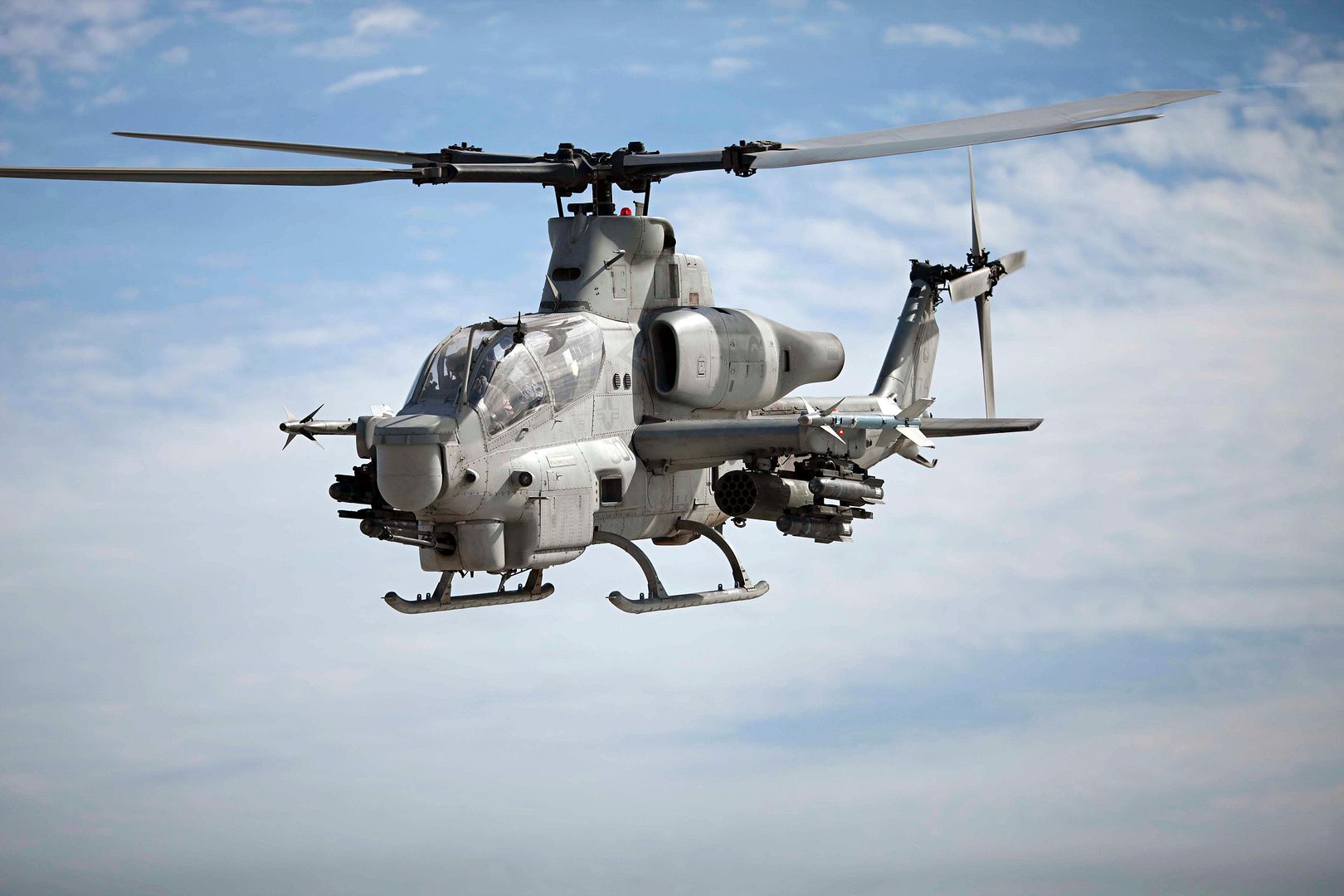
WASHINGTON: The United States (US) Navy awarded a $170 million contract for the manufacture of nine AH-1Z Viper Attack Helicopters to Bell Helicopter, the US Department of Defense said in a statement on Monday.
The combat helicopters will be manufactured and delivered to Pakistan under the Foreign Military Sales Program, the statement said.
The Bell AH-1Z Viper is a twin-engine combat chopper based on the previous SuperCobra model developed for the US Marine Corps, Sputnik reported. It has a top speed of 420 kilometres per hour and a range of 610km.
The contract awarded "for the manufacture and delivery of nine AH-1Z aircraft and nine auxiliary fuel kits for the government of Pakistan" is "expected to be completed in September 2018".
"Foreign military sales funds in the amount of $170,173,188 will be obligated at time of award," the Defense Department statement says, adding that the Naval Air Systems Command is contracting the activity for the Pakistani government.
Last April, the US State Department approved the Foreign Military Sale to Pakistan for the AH-1Z Viper Attack Helicopters and AGM-114R Hellfire II Missiles and associated equipment, parts, training and logistical support for an estimated cost of $952 million.
Read more: US approves billion-dollar arms sale to Pakistan
Earlier this year, the US approved a $700m sale of eight F-16 fighter jets to Pakistan, to which India strongly objected. The sale was made in order to improve Pakistan?s precision strike capability, the US said.
In a document released in February, the US administration told US lawmakers that its Foreign Military Funding (FMF) to Pakistan would focus on seven priority areas "identified and agreed to with the government of Pakistan".
These include "precision strike; air mobility and combat search and rescue; counter-improvised explosive device and survivability; battlefield communications; night operations; border security; and maritime security/counter-narcotics in support of counter-terrorism aims".
The document, sent to Congress with the US administration?s budget proposals for 2017, identifies these areas as essential to enhancing Pakistan?s counter-insurgency and counter-terrorism capabilities.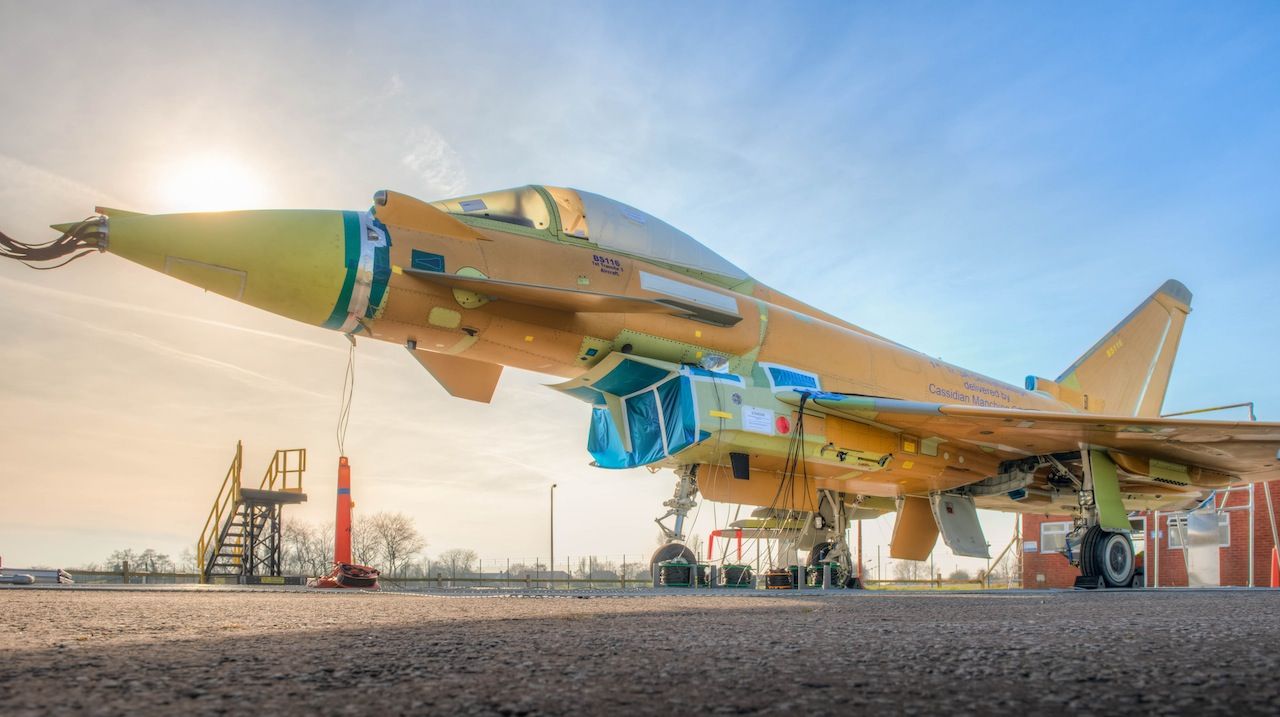
5 April 2016
BAE Systems has received a major boost with Kuwait finally signing a deal to buy 28 Eurofighter Typhoon jets.
In September the Gulf nation first agreed the broad terms of the deal with the Eurofighter consortium - made up of FTSE 100-listed BAE, France's Airbus, and Italy?s Finmeccanica, which led the sales campaign.
The sale is thought to be worth in the region of ?7bn (?5.6bn) in total and includes service support as well as training for flight and ground crew.
Finmeccanica will receive about half of the total value, with the remainder being split between Airbus and BAE, which produces the front fuselage of the jets, parts of the tailplane, and smaller parts at its plants in the North West.
Mauro Moretti, chief executive of Finmeccanica, called the deal the company's ?largest ever commercial achievement?.
The jets will be fitted with the first Typhoons equipped with the Electronically Scanned radar which increases the range at which pilots can identify potential targets, as well as allowing them to scan a 200-degree field of vision, greater than rival fighters, giving them a tactical advantage.
Finemeccanica is leading the development of the new radar system, which sustains about 1,000 jobs at the company's sites in Luton and Edinburgh.
BAE described the order as a ?massive boost? for the Typhoon programme, adding that it would secure the company?s production lines until 2018.
-
 Main AdminAn A-29 Super Tucano flies over Afghanistan during a training mission April 6, 2016. The A-29 is a light attack aircraft that can be armed with two 500-pound bombs, twin .50-caliber machine guns and rockets. Aircrews are trained on aerial interdiction and armed overwatch missions that enable a pre-planned strike capability. The Afghan air force currently has eight A-29s but will have 20 by the end of 2018. Train, Advise, Assist Command-Air (TAAC-Air) works daily with the Afghan air force to help build a professional, sustainable and capable air force. (U.S. Air Force photo by Capt. Eydie Sakura/released)
Main AdminAn A-29 Super Tucano flies over Afghanistan during a training mission April 6, 2016. The A-29 is a light attack aircraft that can be armed with two 500-pound bombs, twin .50-caliber machine guns and rockets. Aircrews are trained on aerial interdiction and armed overwatch missions that enable a pre-planned strike capability. The Afghan air force currently has eight A-29s but will have 20 by the end of 2018. Train, Advise, Assist Command-Air (TAAC-Air) works daily with the Afghan air force to help build a professional, sustainable and capable air force. (U.S. Air Force photo by Capt. Eydie Sakura/released)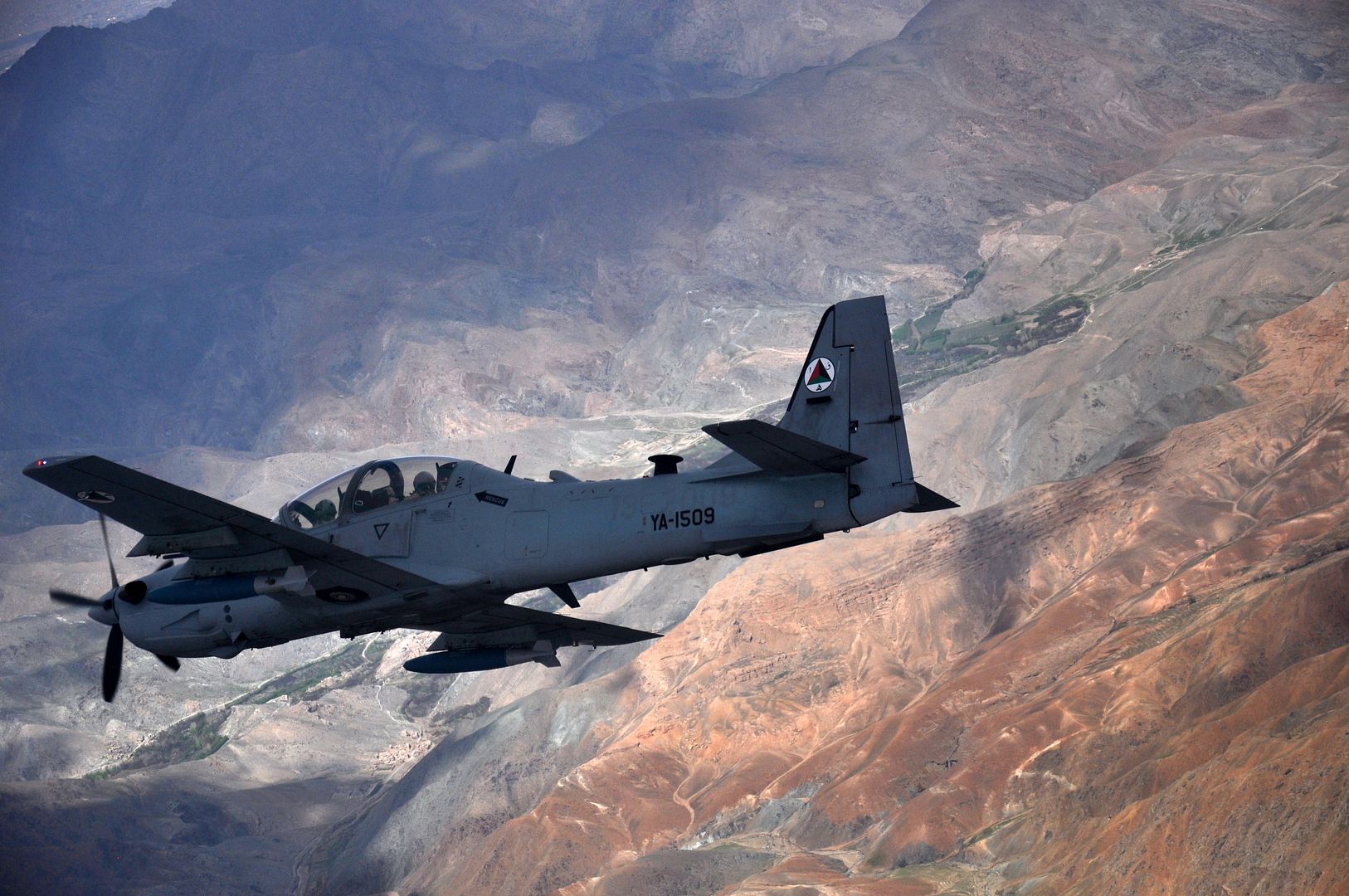
Airmen with the 35th Aircraft Maintenance Squadron arm an F-16 Fighting Falcon during a two-day surge exercise at Misawa Air Base, Japan, April 5, 2016. Along with standard maintenance to aircraft before and after flight, weapons load crew teams armed the aircraft to simulate a combat environment. During deployed operations, loading is essential for the F-16?s air-to-air combat and air-to-surface attacks. (U.S. Air Force photo/Airman 1st Class Jordyn Fetter)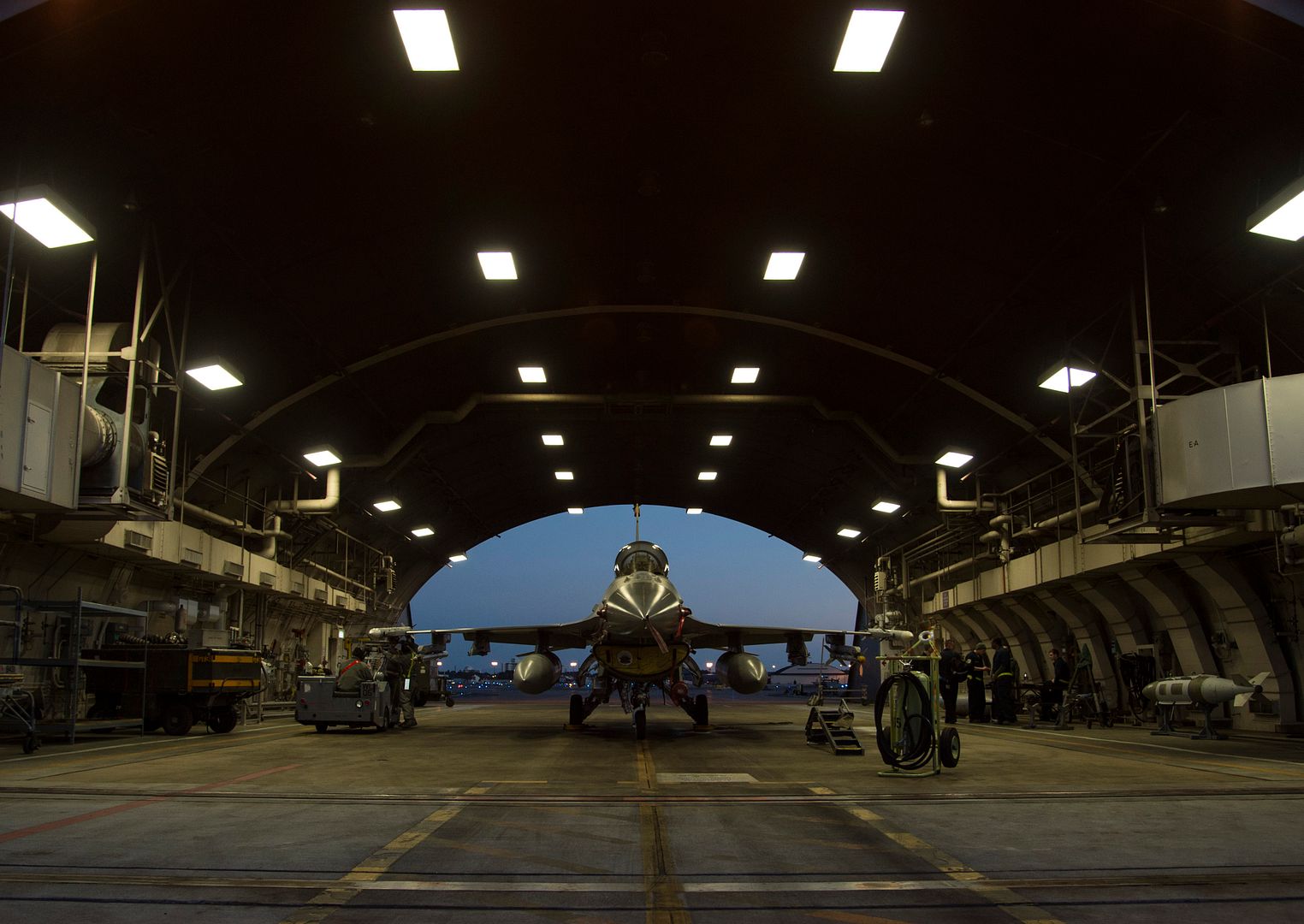
-
 Main AdminATLANTIC OCEAN (April 6, 2016) - An F/A-18E Super Hornet assigned to the Gunslingers of Strike Fighter Squadron (VFA) 105 prepares to land on the flight deck of the aircraft carrier USS Dwight D. Eisenhower (CVN 69), the flagship of the Eisenhower Carrier Strike Group. Ike is underway conducting a Composite Training Unit Exercise (COMPTUEX) with the Eisenhower Carrier Strike Group in preparation for a future deployment. (U.S. Navy photo by Mass Communication Specialist 3rd Class J. Alexander Delgado/Released)
Main AdminATLANTIC OCEAN (April 6, 2016) - An F/A-18E Super Hornet assigned to the Gunslingers of Strike Fighter Squadron (VFA) 105 prepares to land on the flight deck of the aircraft carrier USS Dwight D. Eisenhower (CVN 69), the flagship of the Eisenhower Carrier Strike Group. Ike is underway conducting a Composite Training Unit Exercise (COMPTUEX) with the Eisenhower Carrier Strike Group in preparation for a future deployment. (U.S. Navy photo by Mass Communication Specialist 3rd Class J. Alexander Delgado/Released)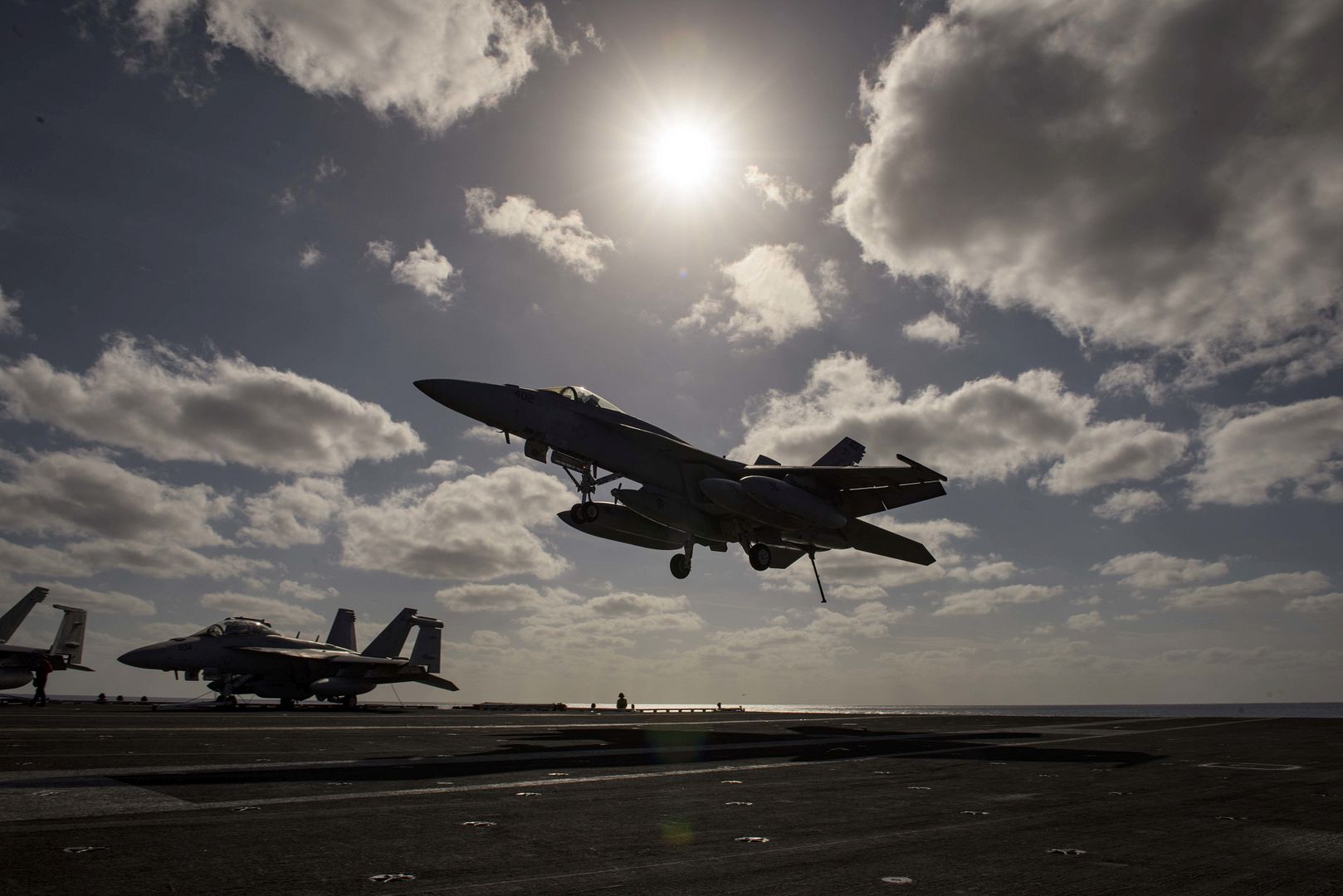
ATLANTIC OCEAN (April 6, 2016) - An F/A-18E Super Hornet assigned to the Gunslingers of Strike Fighter Squadron (VFA) 105 lands on the flight deck of the aircraft carrier USS Dwight D. Eisenhower (CVN 69), the flagship of the Eisenhower Carrier Strike Group. Ike is underway conducting a Composite Training Unit Exercise (COMPTUEX) with the Eisenhower Carrier Strike Group in preparation for a future deployment. (U.S. Navy photo by Mass Communication Specialist 3rd Class J. Alexander Delgado/Released)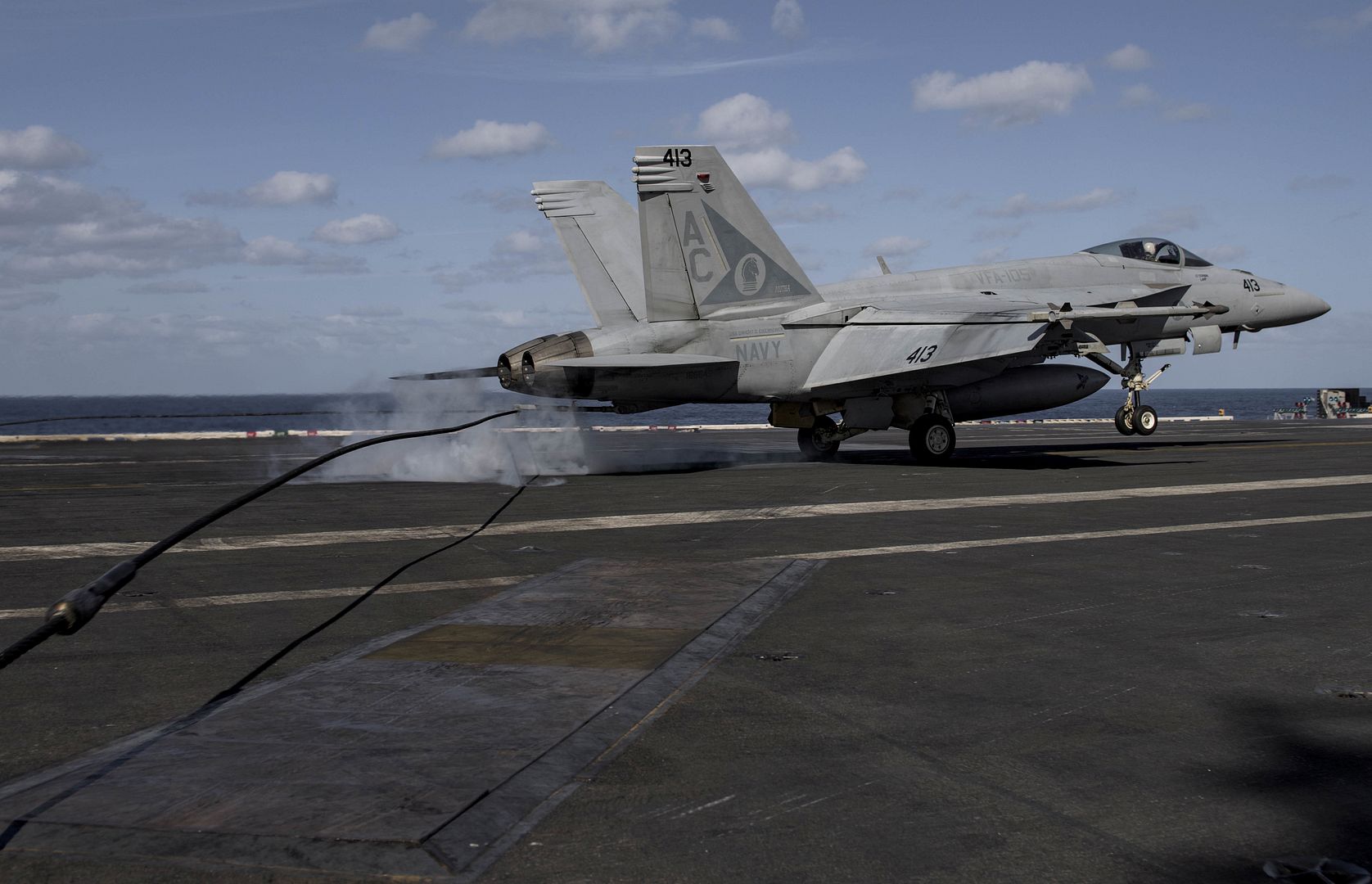
ATLANTIC OCEAN (April 6, 2016) - An F/A-18F Super Hornet assigned to the Fighting Swordsmen of Strike Fighter Squadron (VFA) 32 takes off from the flight deck of the aircraft carrier USS Dwight D. Eisenhower (CVN 69), the flagship of the Eisenhower Carrier Strike Group. Ike is underway conducting a Composite Training Unit Exercise (COMPTUEX) with the Eisenhower Carrier Strike Group in preparation for a future deployment. (U.S. Navy photo by Mass Communication Specialist 3rd Class J. Alexander Delgado/Released)
A U.S. Air Force F-15 Strike Eagle approaches a KC-135 Stratotanker to refuel over Iraq in support of Operation Inherent Resolve, April 6, 2016. The United States stands with a coalition of more than 60 international partners to assist and support the Iraq Security Forces to degrade and defeat ISIL. (U.S. Air Force photo by Tech. Sgt. Nathan Lipscomb)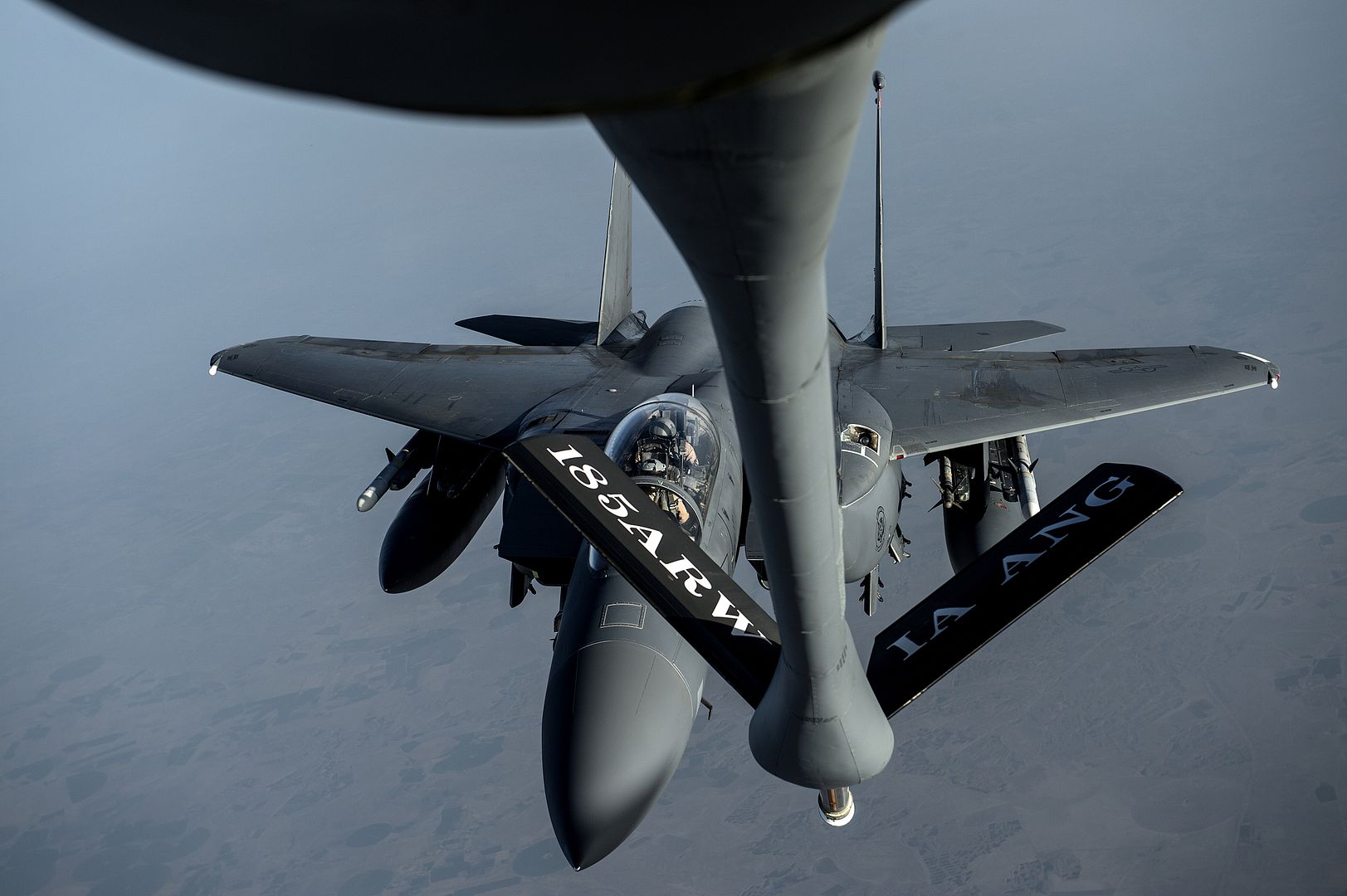
An F-15 Strike Eagle refuels over Iraq in support of Operation Inherent Resolve, April 6, 2016. OIR is the coalition intervention against the Islamic State of Iraq and the Levant. (U.S. Air Force photo by Tech. Sgt. Nathan Lipscomb)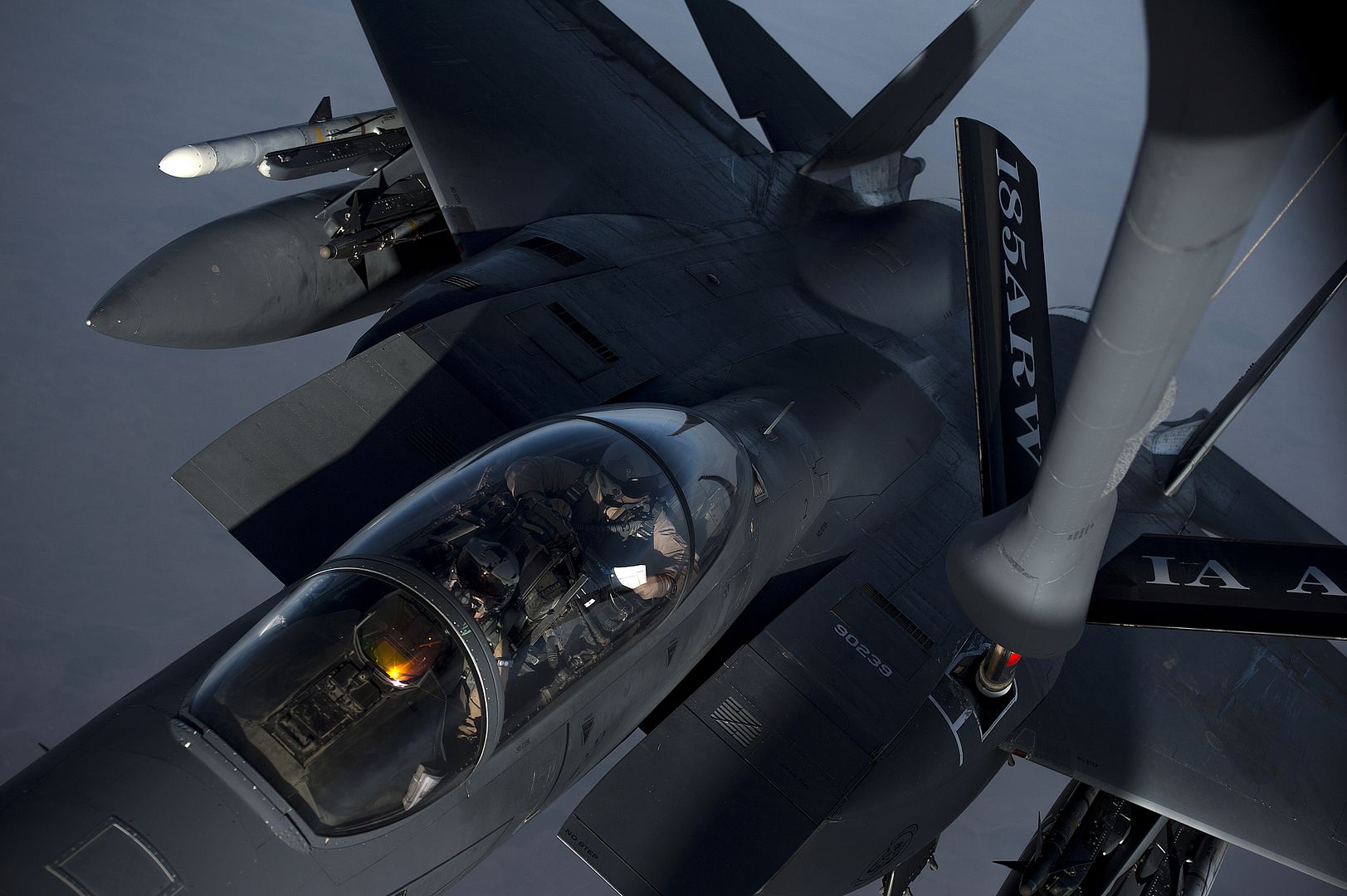
A U.S. Air Force F-15 Strike Eagle flies over Iraq in support of Operation Inherent Resolve, April 6, 2016. U.S. security cooperation has contributed to Iraq's significant progress in halting ISIL's momentum and in some places reversing it. (U.S. Air Force photo by Tech. Sgt. Nathan Lipscomb)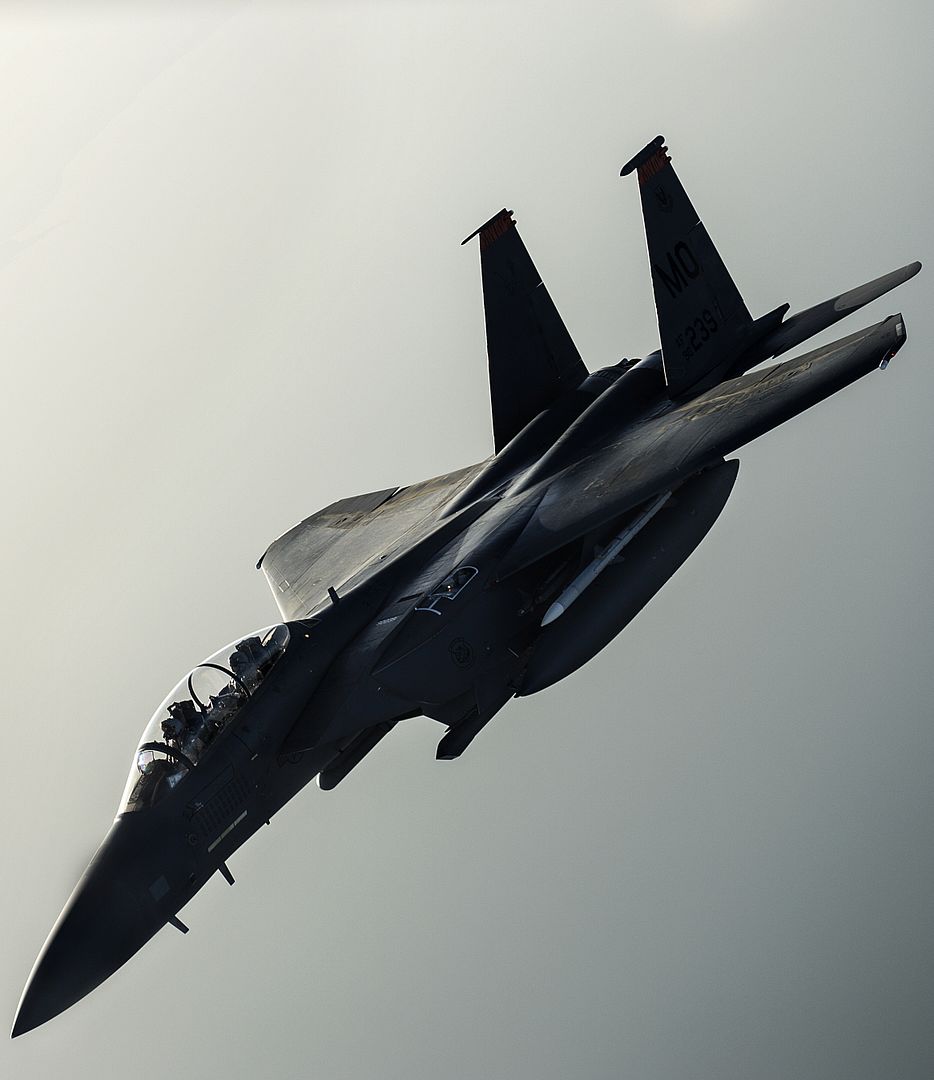
-
9 years agoSat Apr 09 2016, 04:11am
 Main AdminAn F-15E Strike Eagle from the 492nd Fighter Squadron, Royal Air Force Lakenheath, England, flies in formation with Israeli air force F-16C and F-16D Fighting Falcon aircraft, April 7, 2016, during exercise INIOHOS 16. The Hellenic air force-hosted training event enhances interoperability, capabilities, and skills amongst allied and partner air forces. (Courtesy photo by Ioannis Lekkas/Released)
Main AdminAn F-15E Strike Eagle from the 492nd Fighter Squadron, Royal Air Force Lakenheath, England, flies in formation with Israeli air force F-16C and F-16D Fighting Falcon aircraft, April 7, 2016, during exercise INIOHOS 16. The Hellenic air force-hosted training event enhances interoperability, capabilities, and skills amongst allied and partner air forces. (Courtesy photo by Ioannis Lekkas/Released)
-
 Main AdminAL UDEID AIR BASE, Qatar (AFNS) -- U.S. Air Force B-52 Stratofortress aircraft from Barksdale Air Force Base, Louisiana, arrived at Al Udeid Air Base, Qatar, April 9, in support of theater requirements and Operation Inherent Resolve, the operation to eliminate the Islamic State of Iraq and the Levant and the threat they pose to Iraq, Syria and the wider international community.
Main AdminAL UDEID AIR BASE, Qatar (AFNS) -- U.S. Air Force B-52 Stratofortress aircraft from Barksdale Air Force Base, Louisiana, arrived at Al Udeid Air Base, Qatar, April 9, in support of theater requirements and Operation Inherent Resolve, the operation to eliminate the Islamic State of Iraq and the Levant and the threat they pose to Iraq, Syria and the wider international community.
"The B-52 will provide the coalition continued precision and deliver desired airpower effects,? said Lt. Gen. Charles Q. Brown Jr., the commander of U.S. Air Forces Central Command and Combined Forces Air Component. ?As a multi-role platform, the B-52 offers diverse capabilities including delivery of precision weapons and the flexibility and endurance needed to support the combatant commanders? priorities and strengthen the coalition team."
The 19-nation air coalition consists of numerous strike aircraft and the B-52s will bring their unique capability to the fight against ISIL.
The B-52 is a long-range heavy bomber that can perform a variety of missions including strategic attack, close-air support, air interdiction and maritime operations.
Crews will be available to carry out missions in both Iraq and Syria as needed to support air tasking order requirements.
"The B-52 demonstrates our continued resolve to apply persistent pressure on (ISIL) and defend the region in any future contingency,? Brown said.
This deployment is the first basing of the B-52s in the U.S. Central Command area of responsibility in 26 years. The B-52s were based in Saudi Arabia supporting Operation Desert Storm. The B-52s were last flown operationally during Operation Enduring Freedom in May 2006, and during Exercise Eager Lion, a USCENTCOM-led multilateral exercise in Jordan, in May 2015.
The coalition conducted more than 33,000 airpower missions in support of OIR. Since the beginning of the operation, the coalition struck about 459 vehicle-borne improvised explosive devices, 776 mortar systems, 1,933 logistics buildings housing these weapons, 662 weapons caches, and 1,341 staging areas.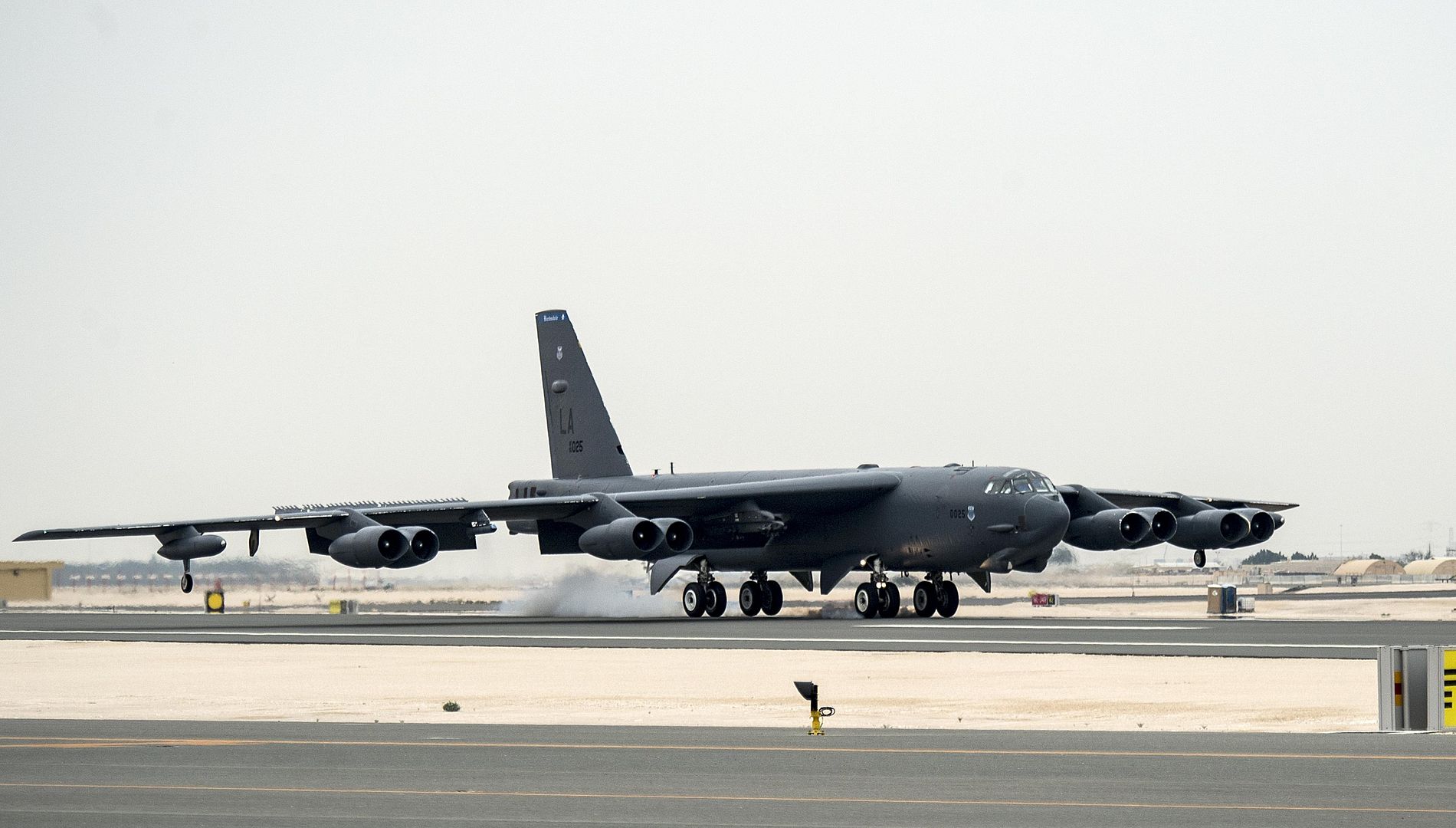
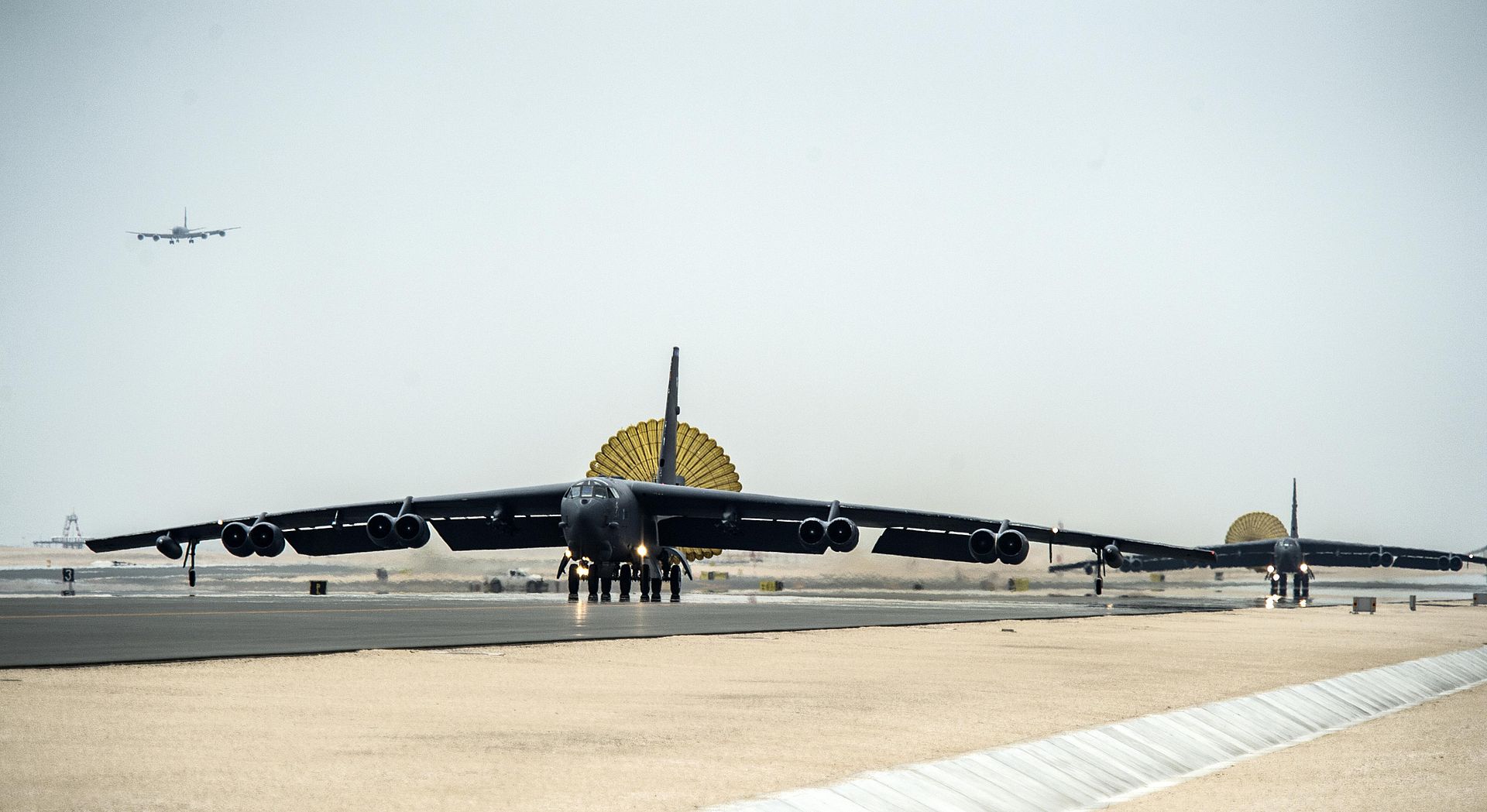
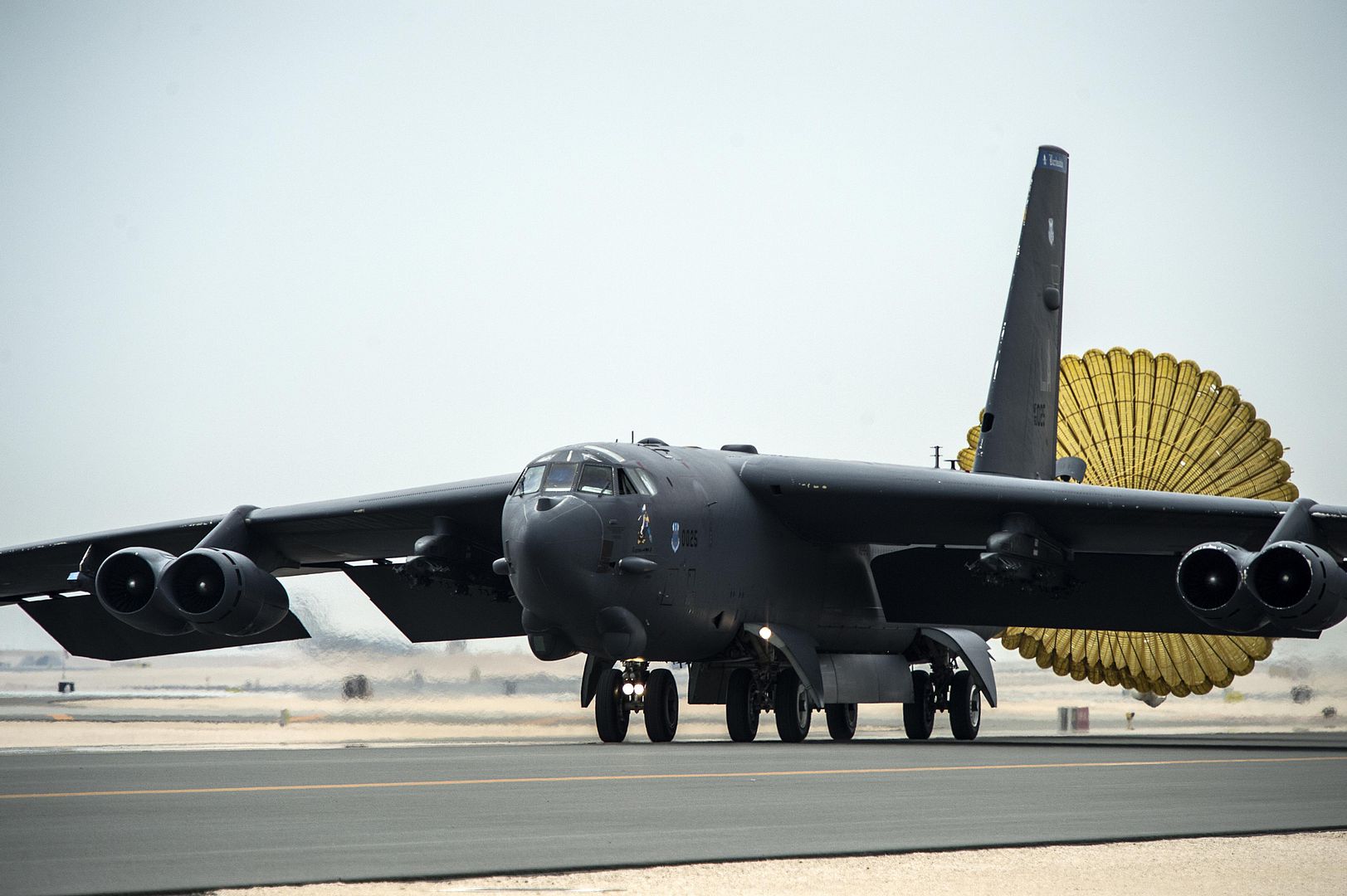
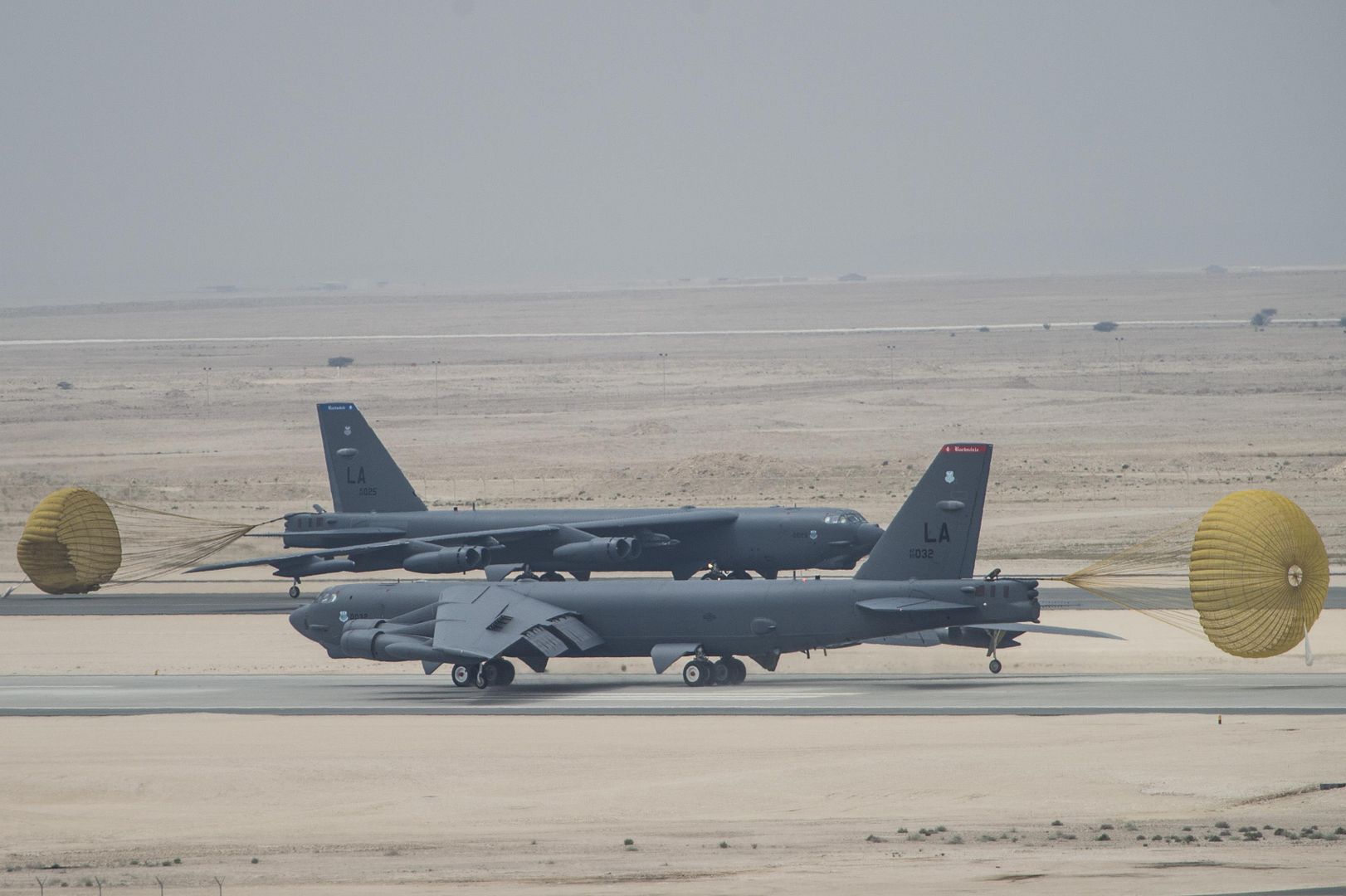
Post a reply
- Go to Previous topic
- Go to Next topic
- Go to Welcome
- Go to Introduce Yourself
- Go to General Discussion
- Go to Screenshots, Images and Videos
- Go to Off topic
- Go to Works in Progress
- Go to Skinning Tips / Tutorials
- Go to Skin Requests
- Go to IJAAF Library
- Go to Luftwaffe Library
- Go to RAF Library
- Go to USAAF / USN Library
- Go to Misc Library
- Go to The Ops Room
- Go to Made in Germany
- Go to Campaigns and Missions
- Go to Works in Progress
- Go to Juri's Air-Raid Shelter
- Go to Campaigns and Missions
- Go to Works in Progress
- Go to Skinpacks
- Go to External Projects Discussion
- Go to Books & Resources
